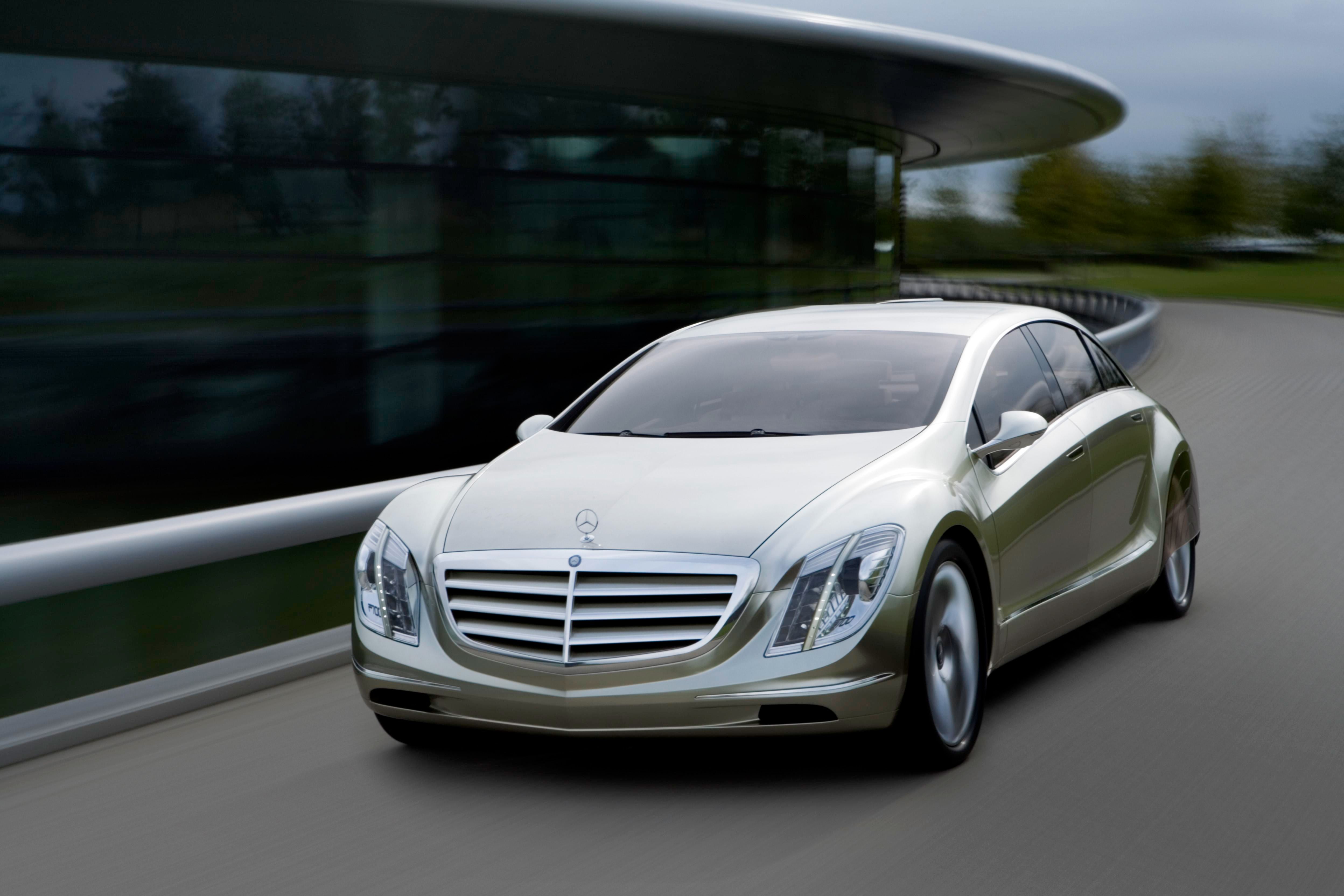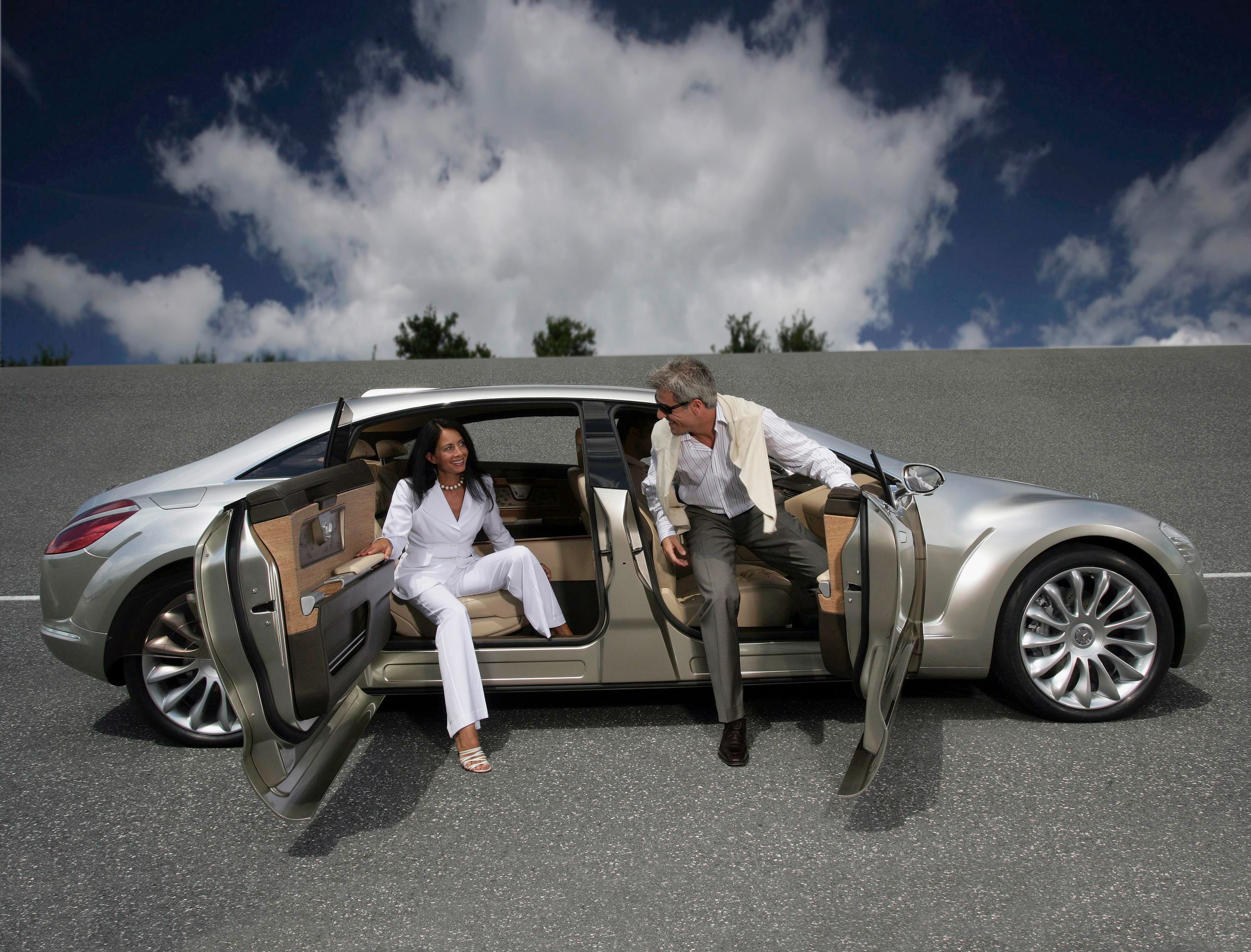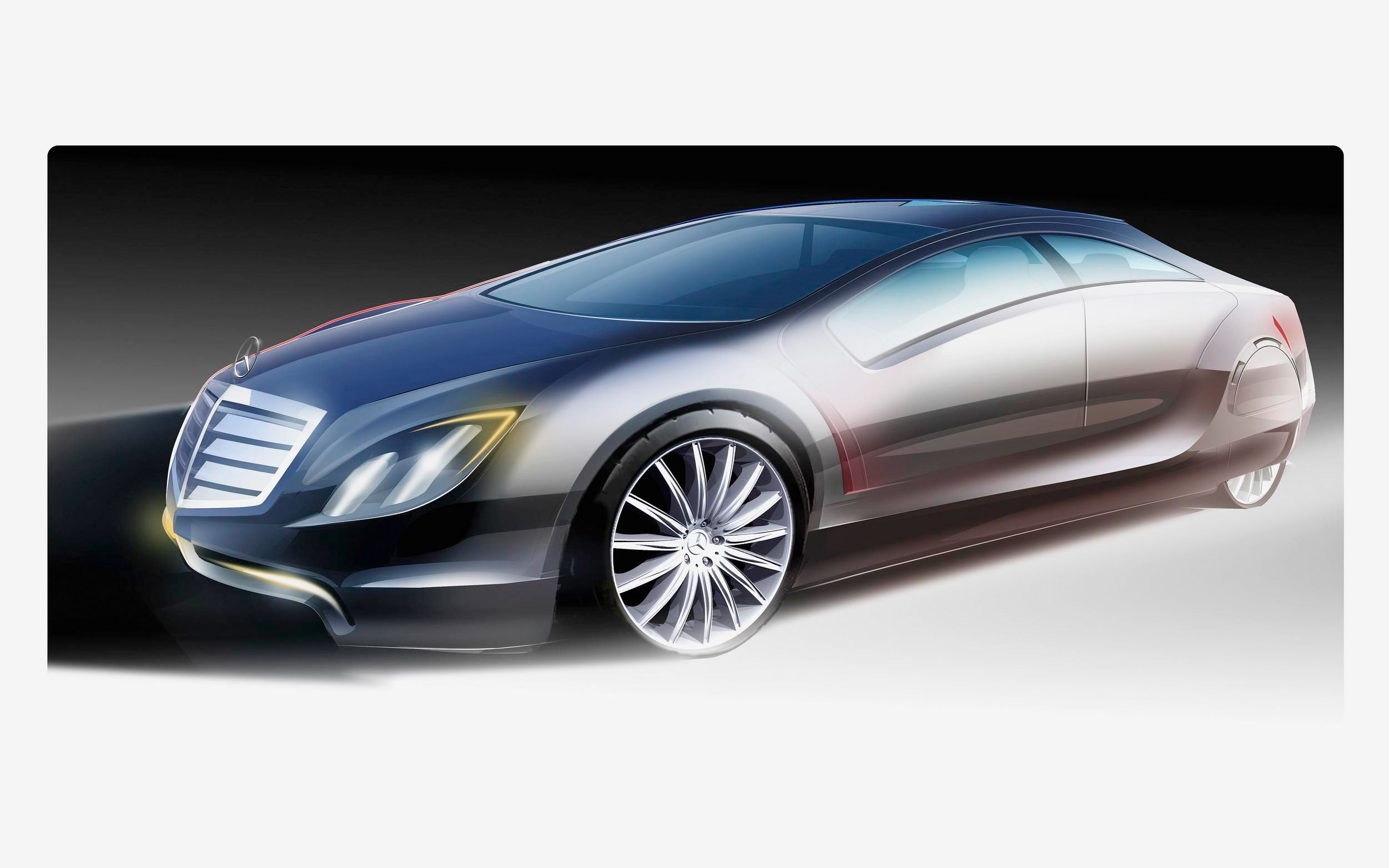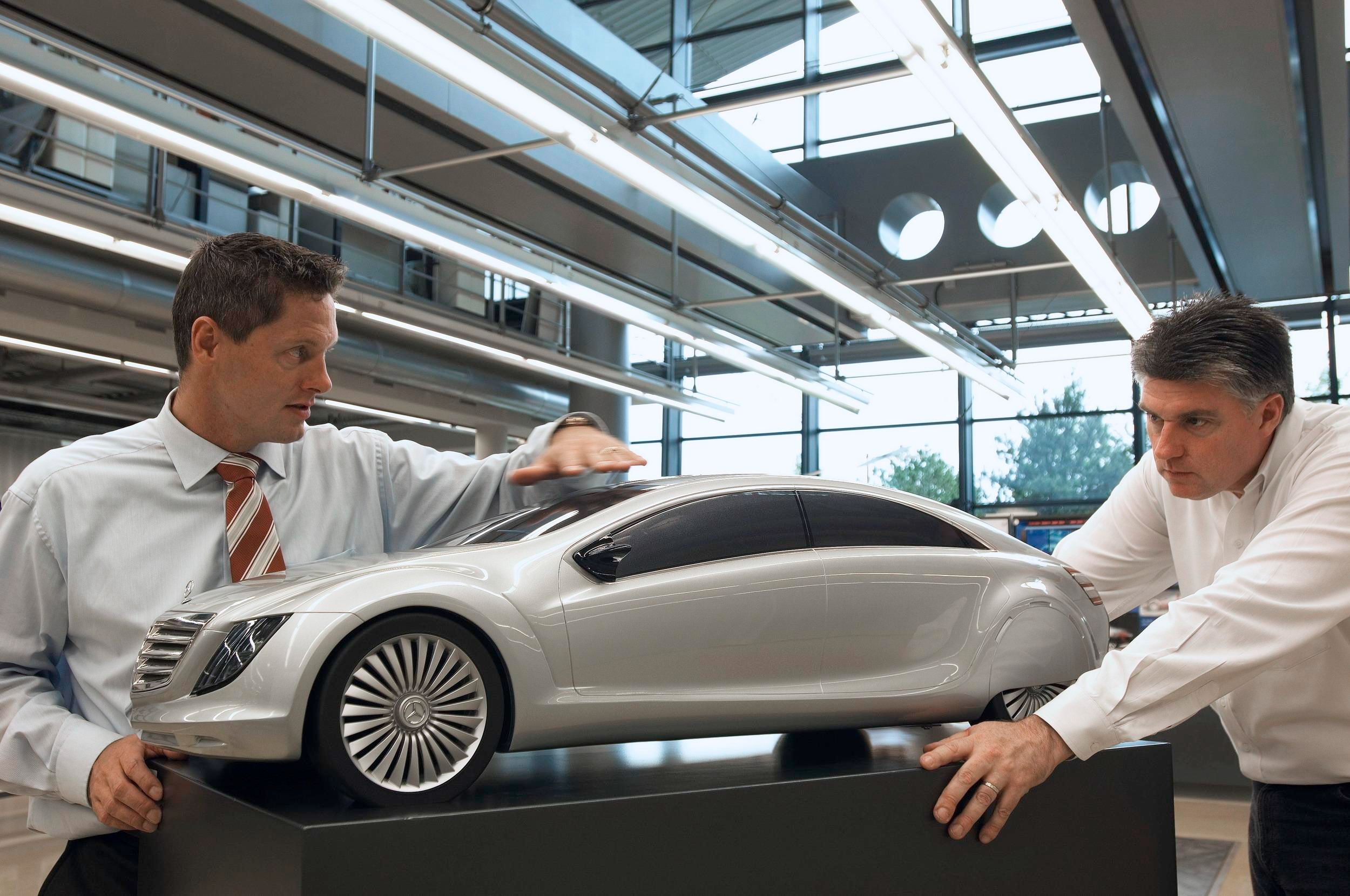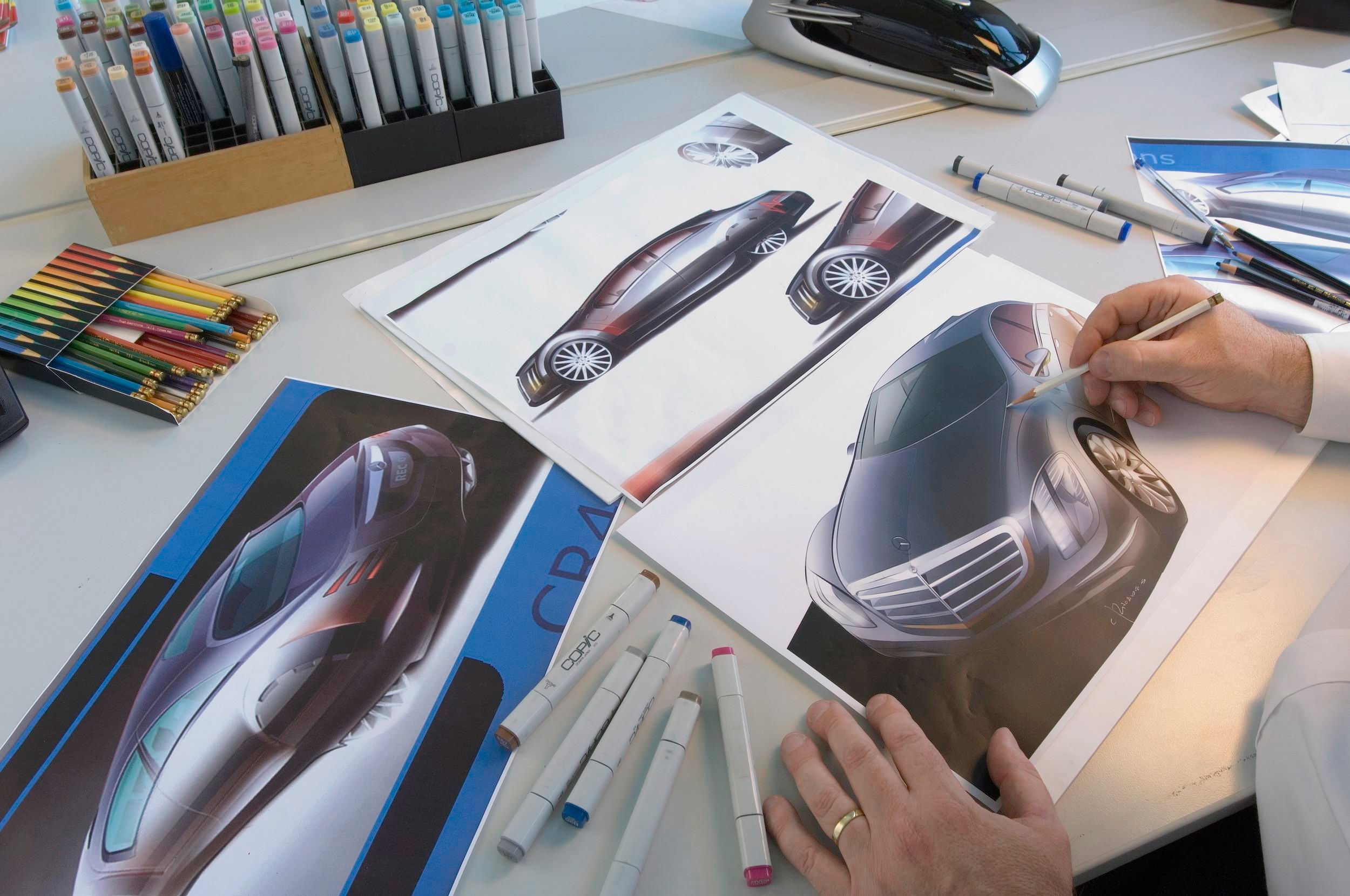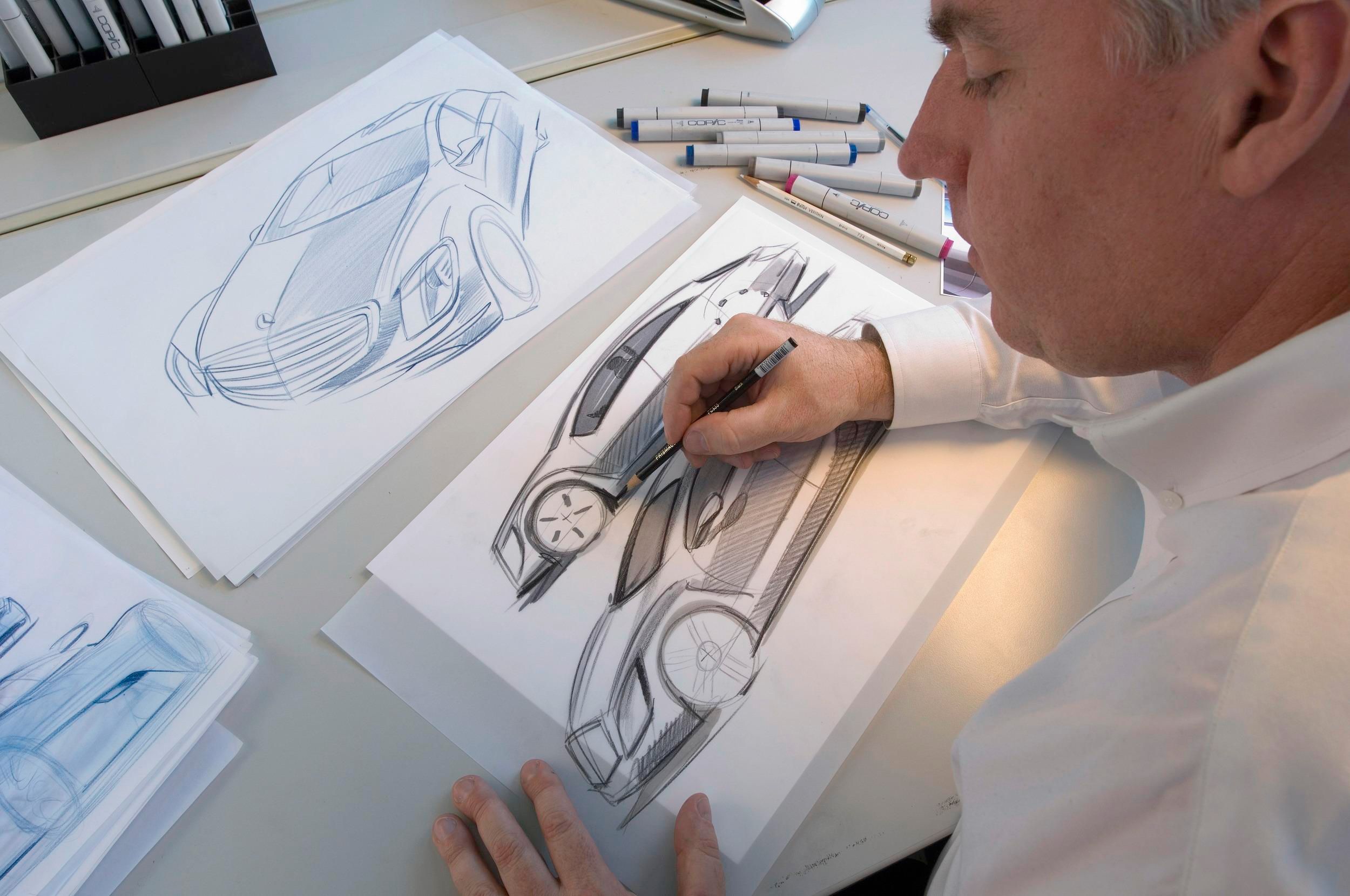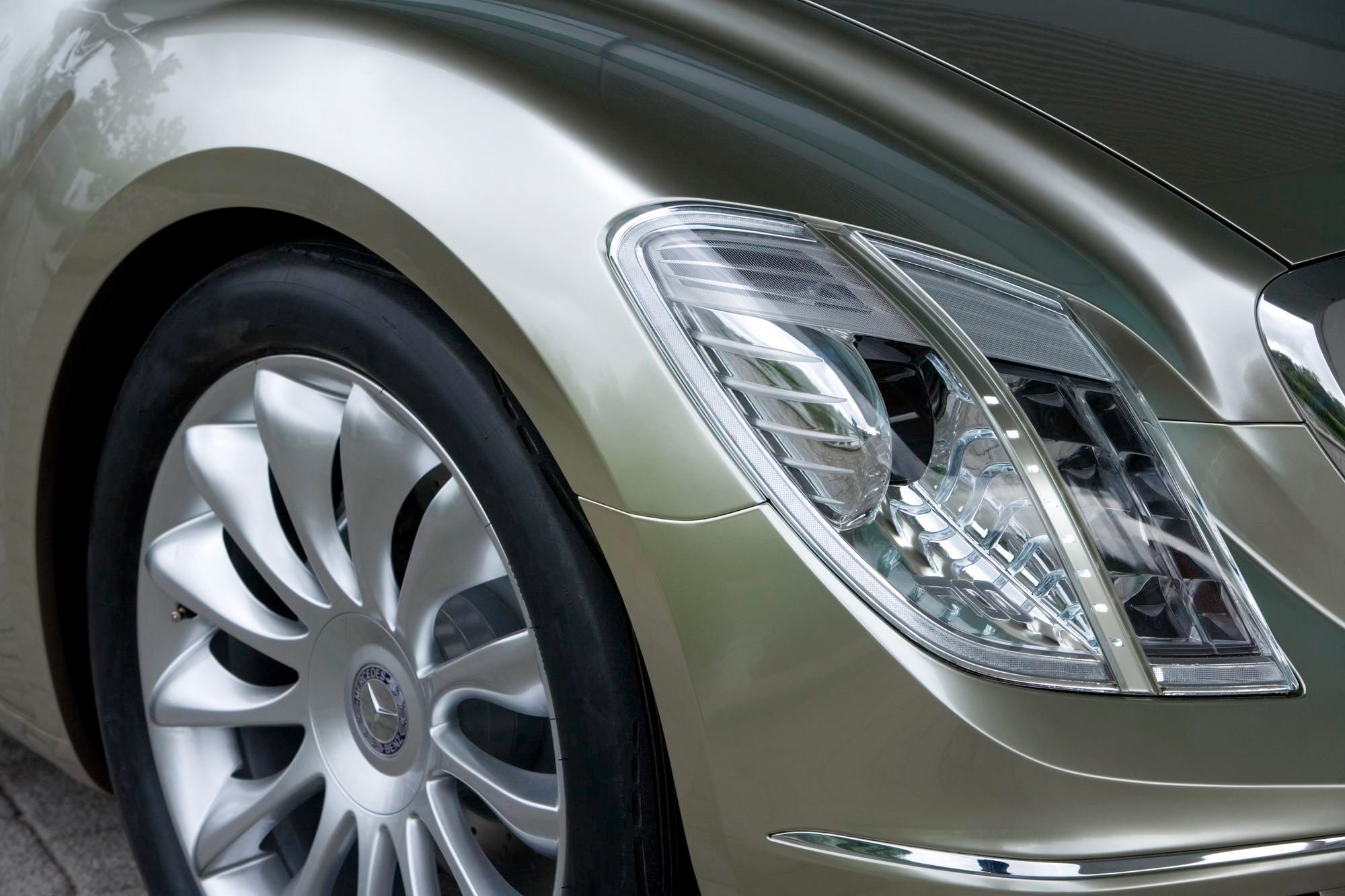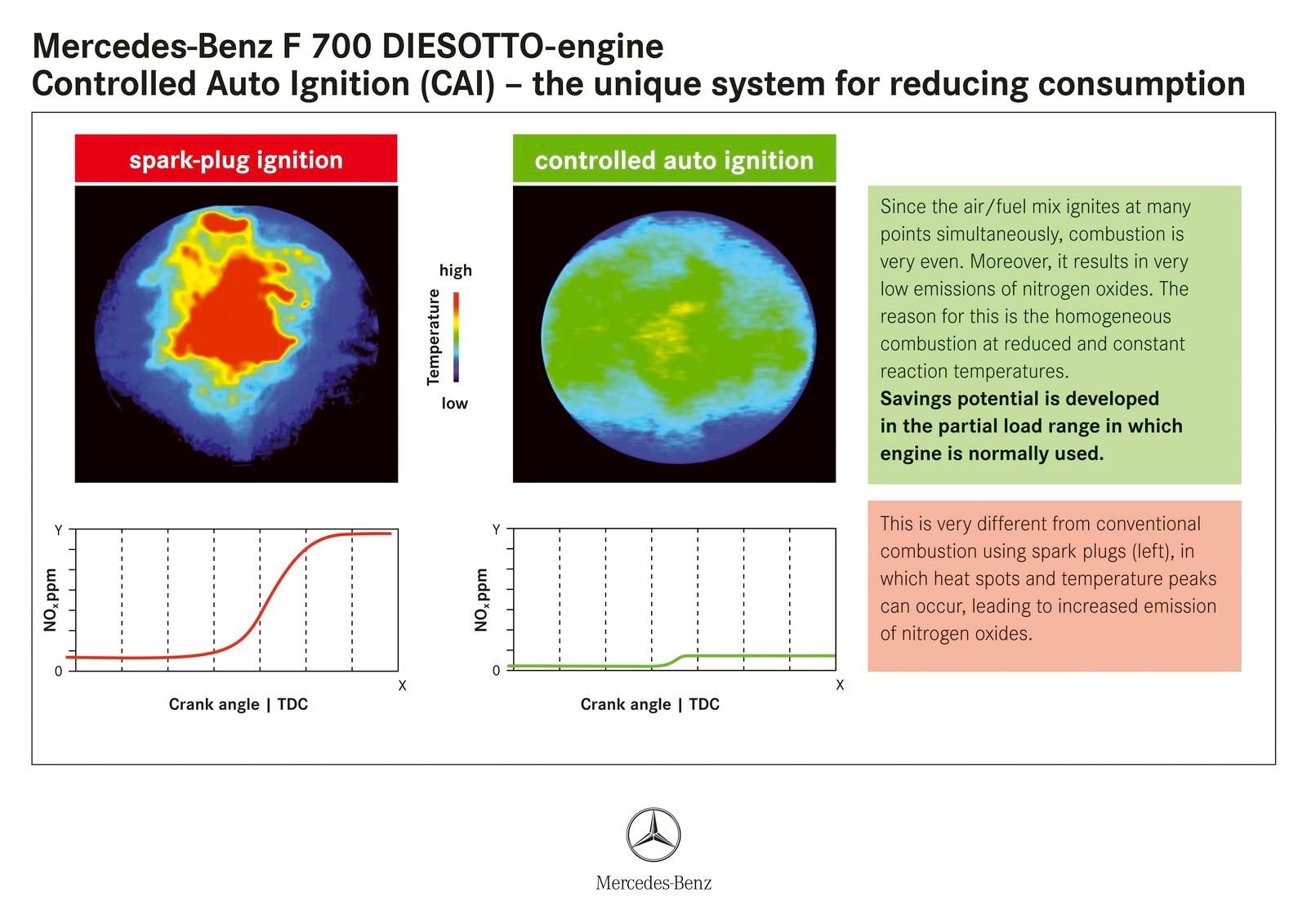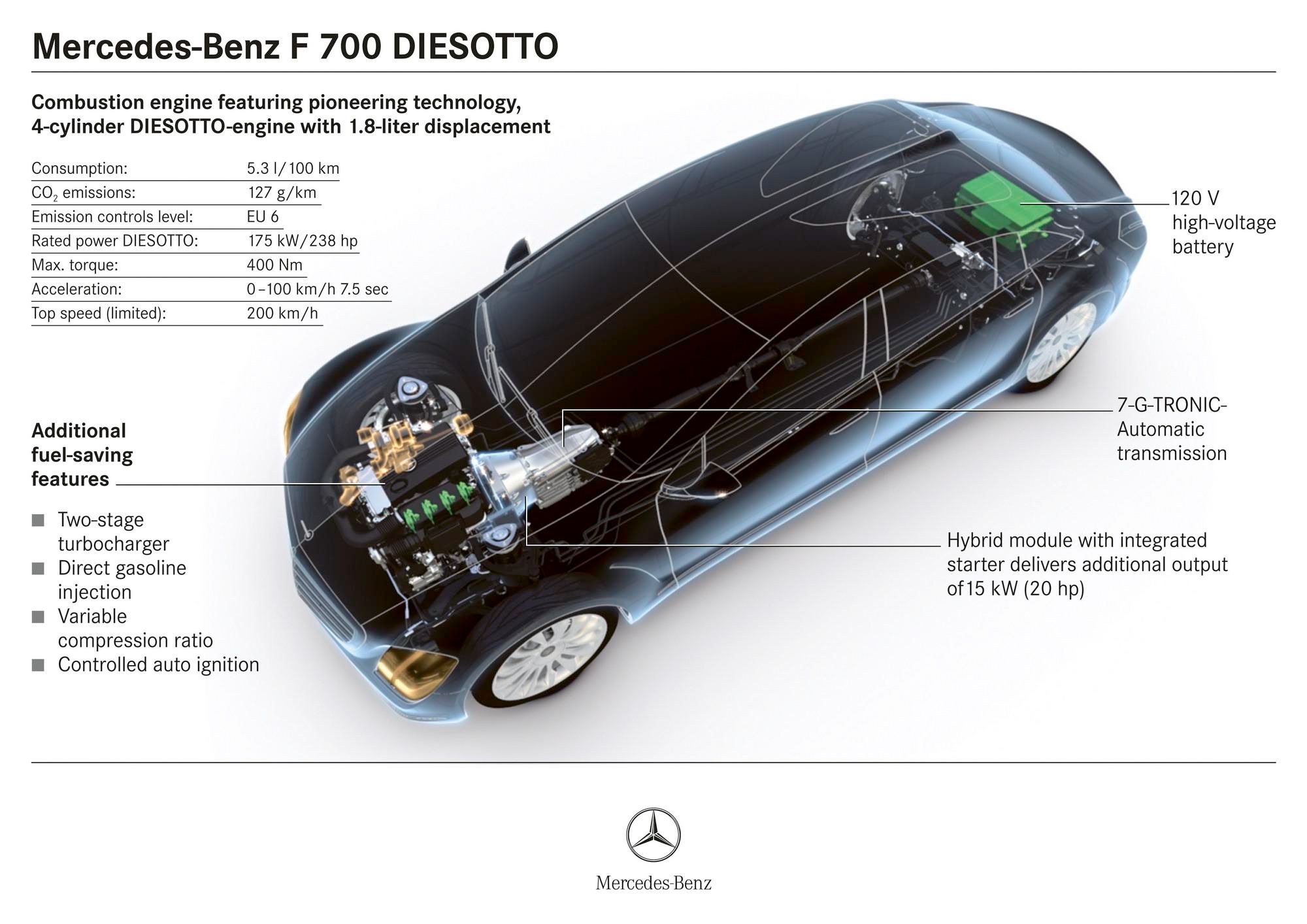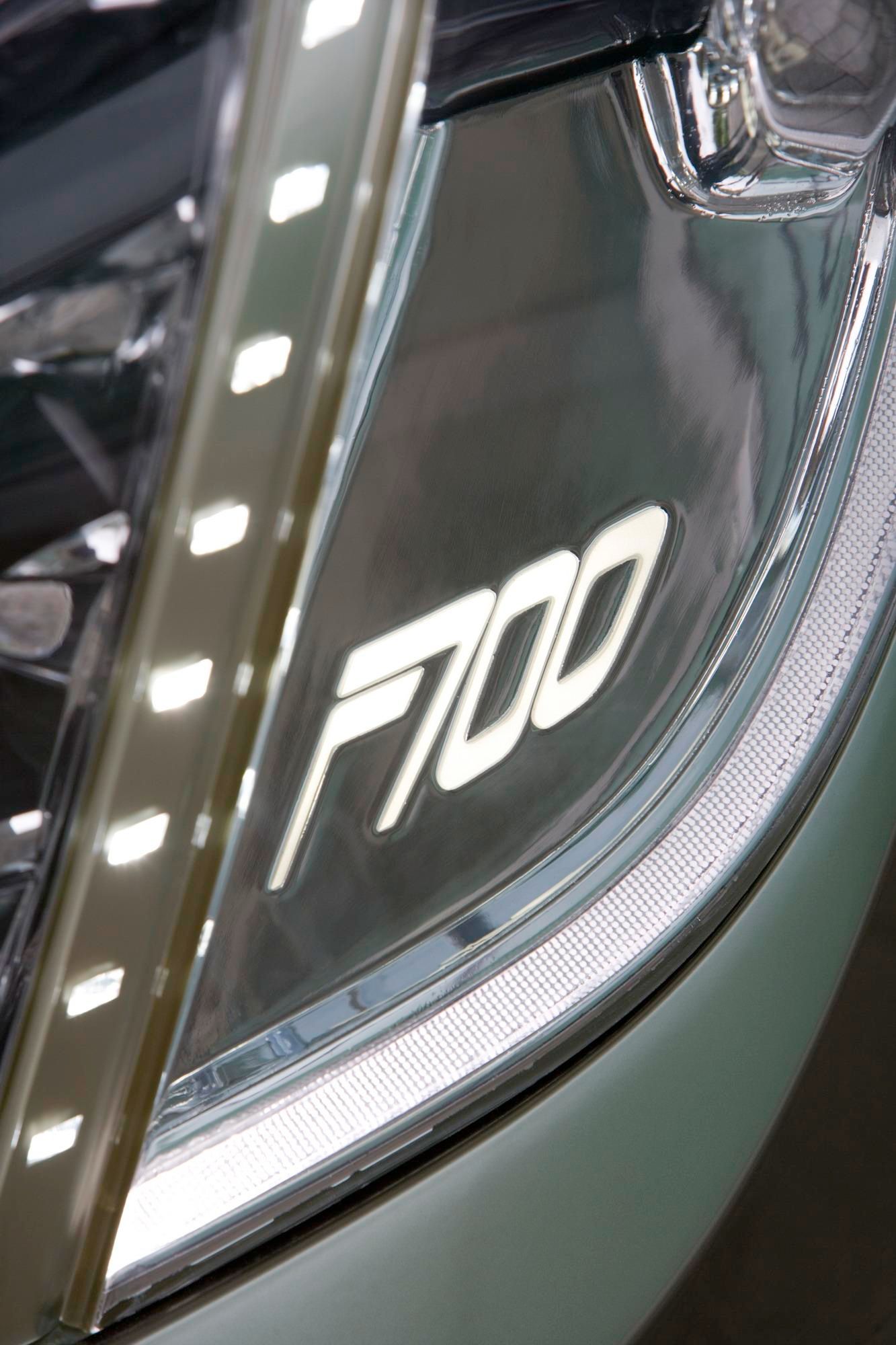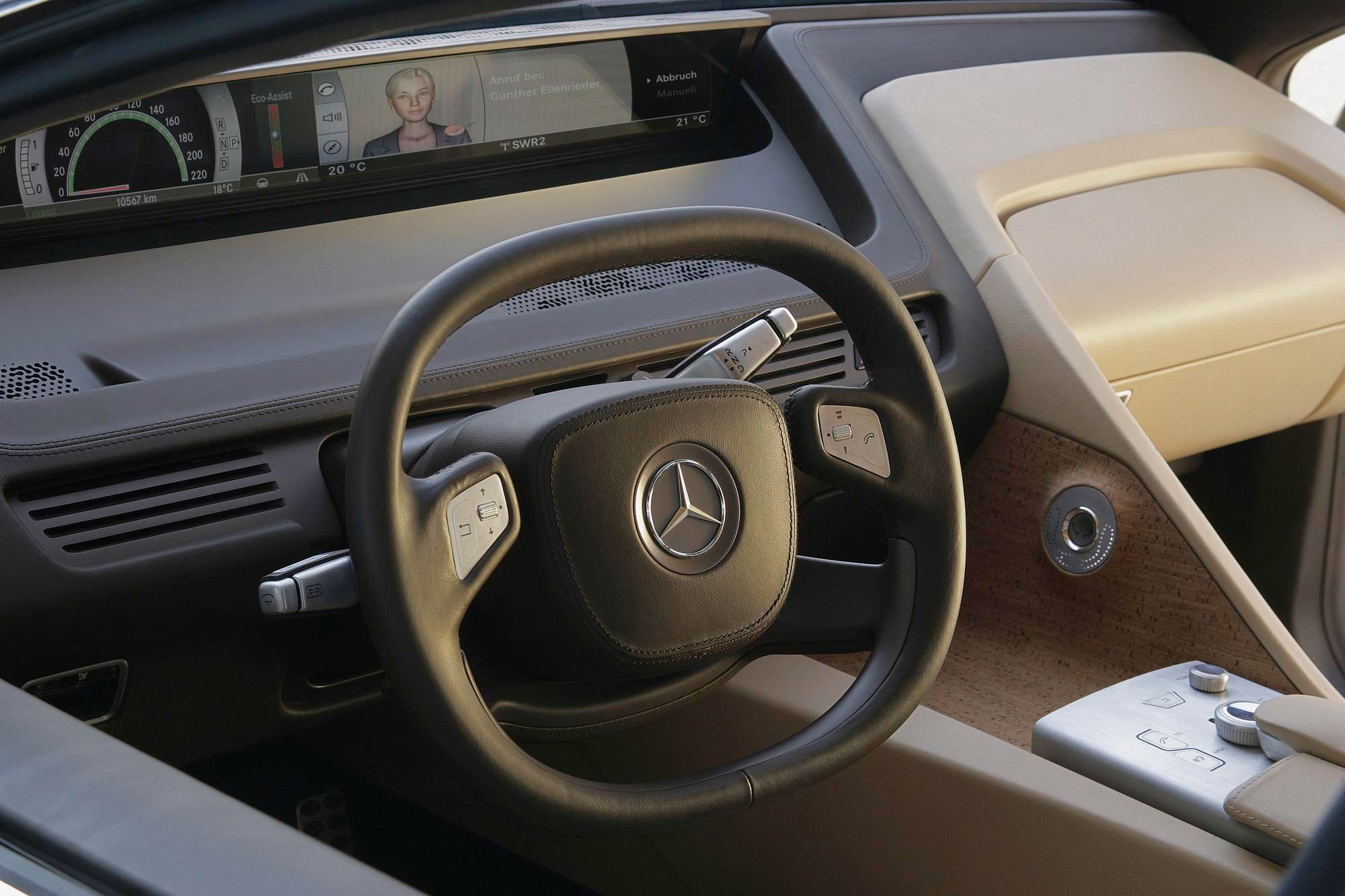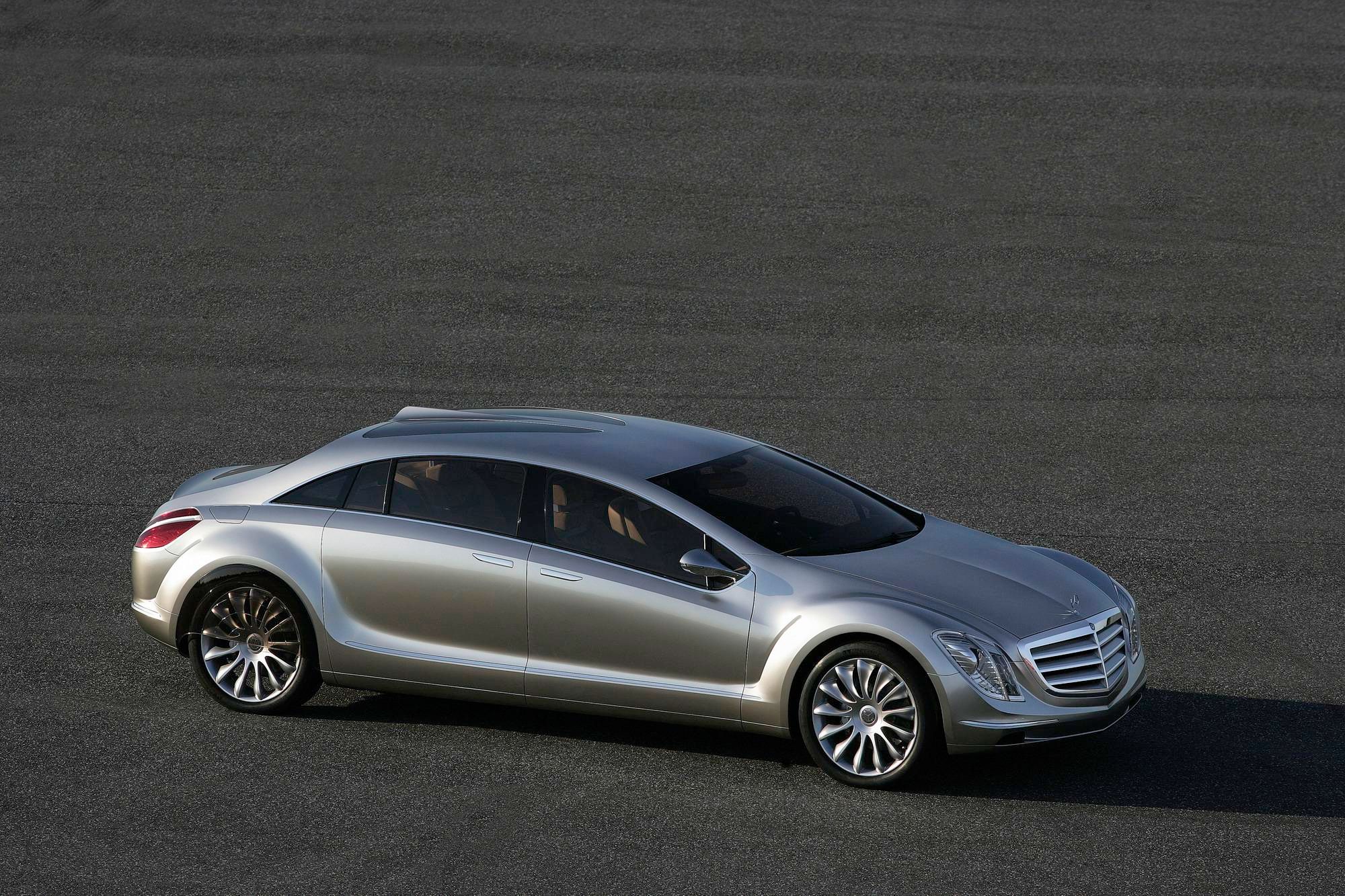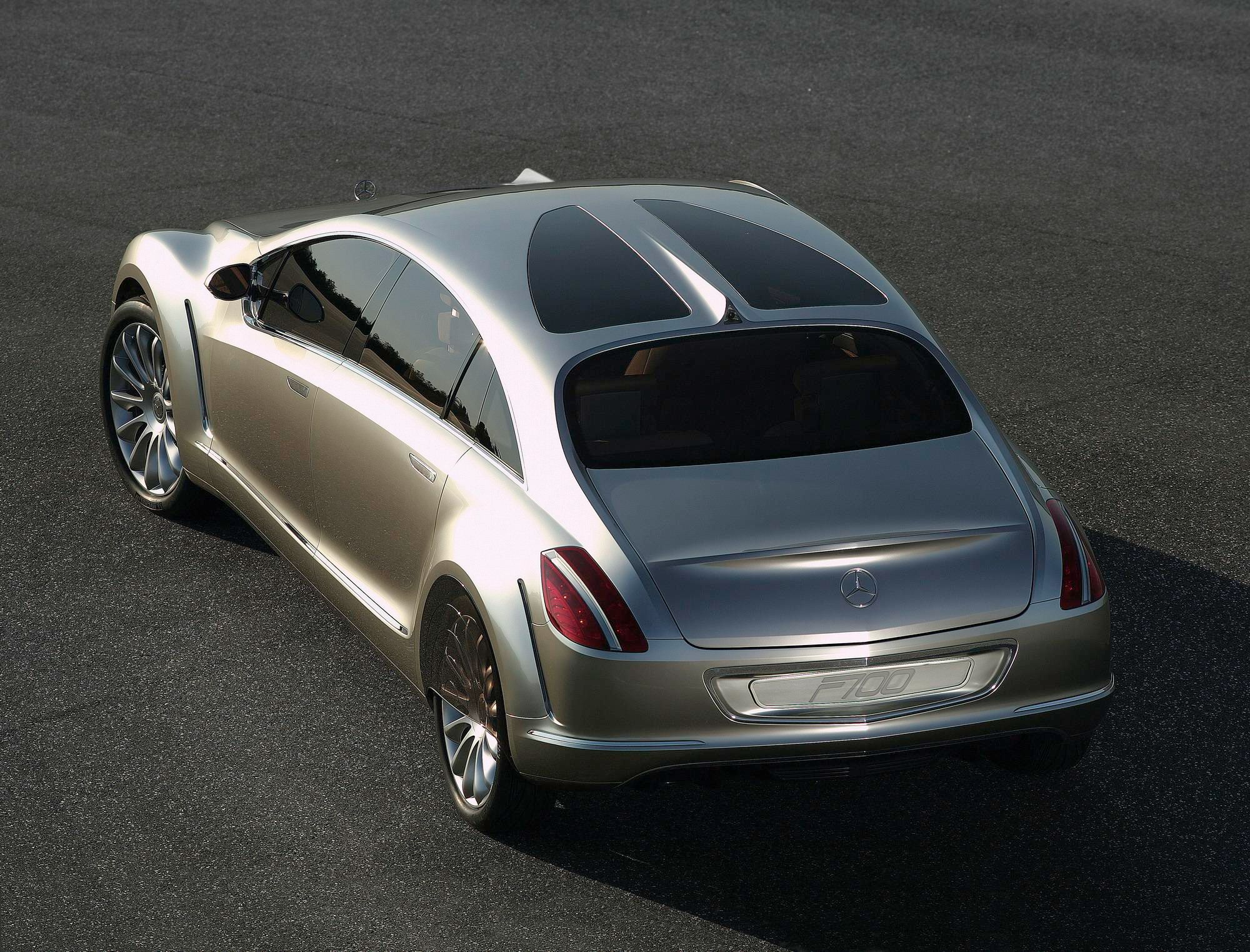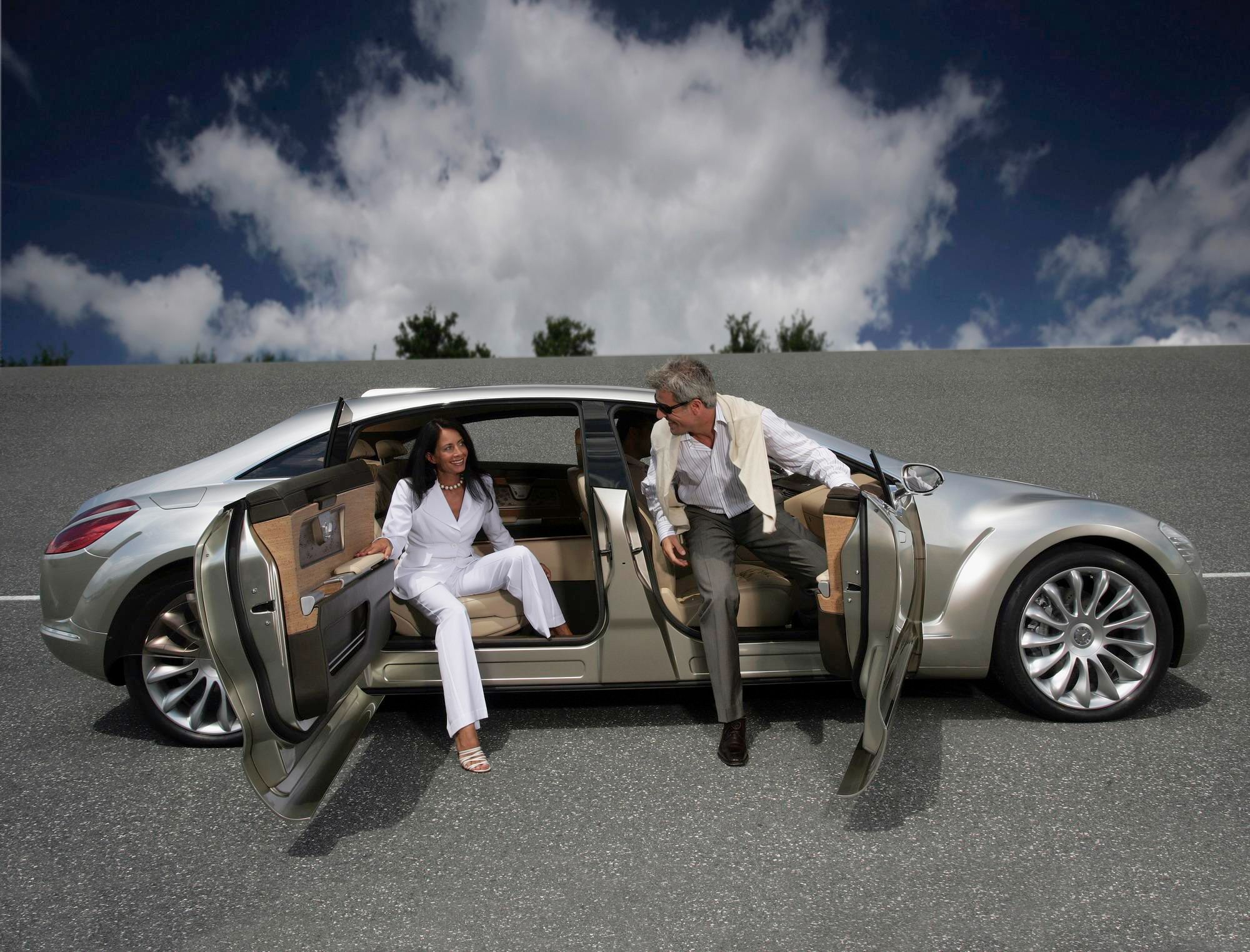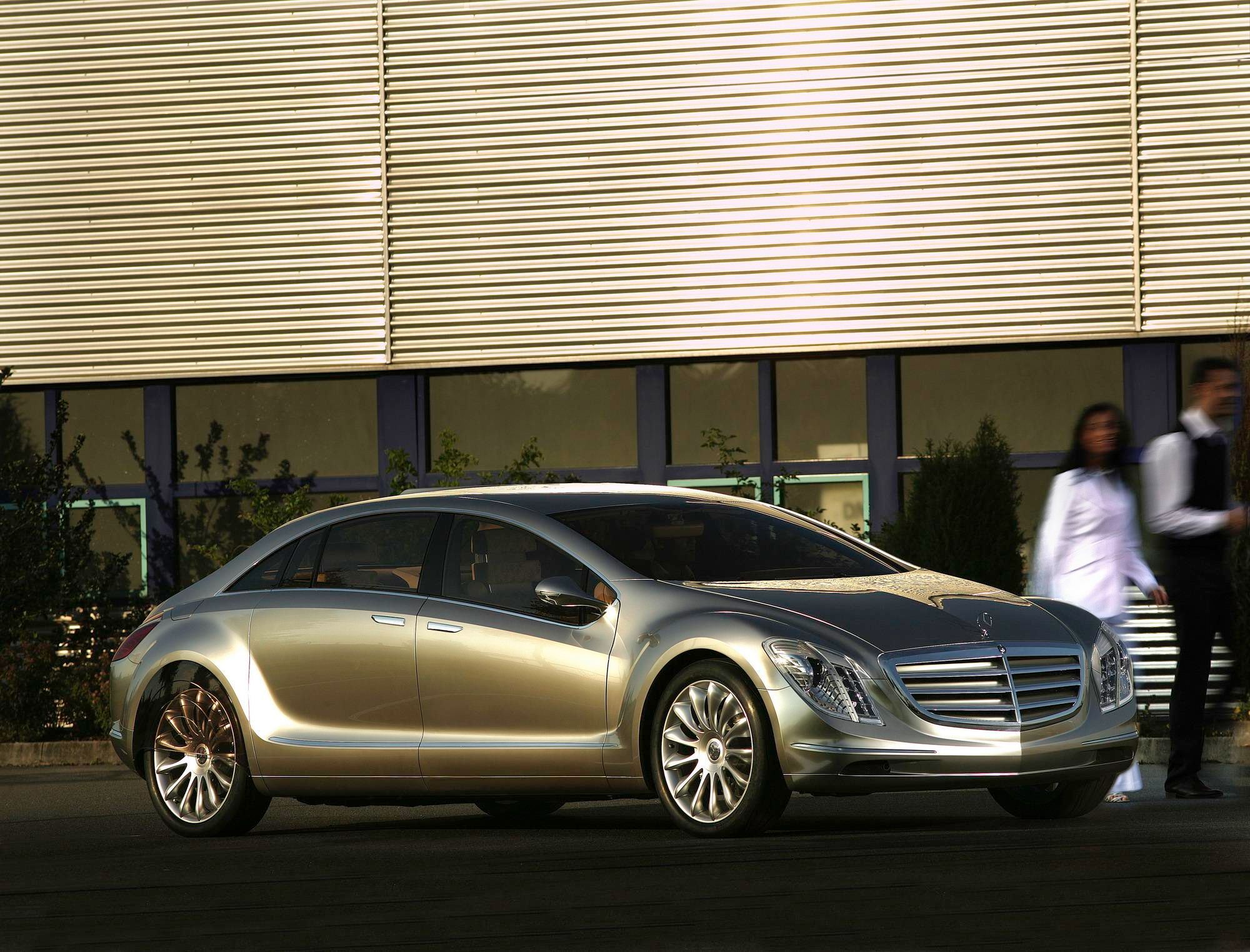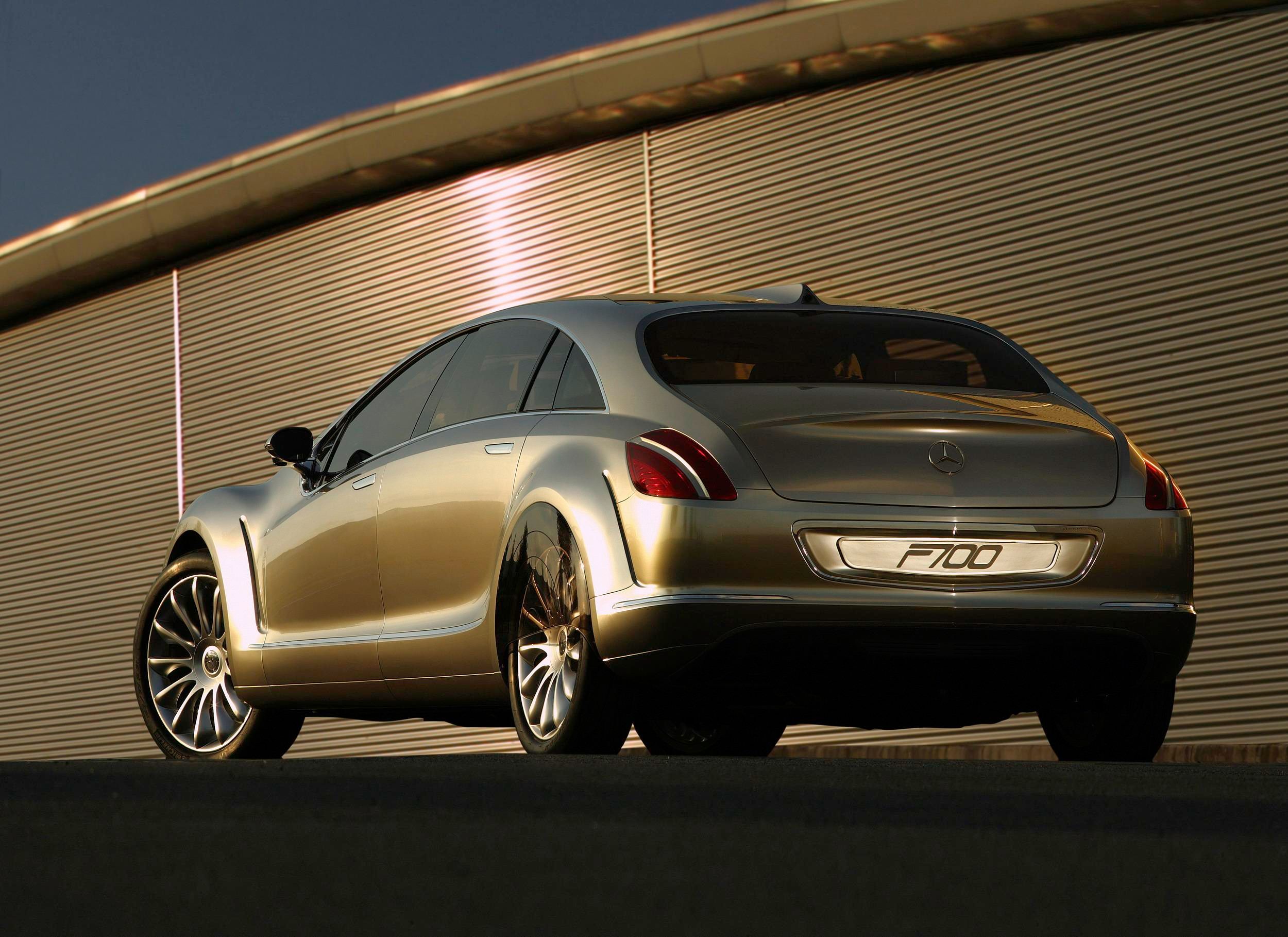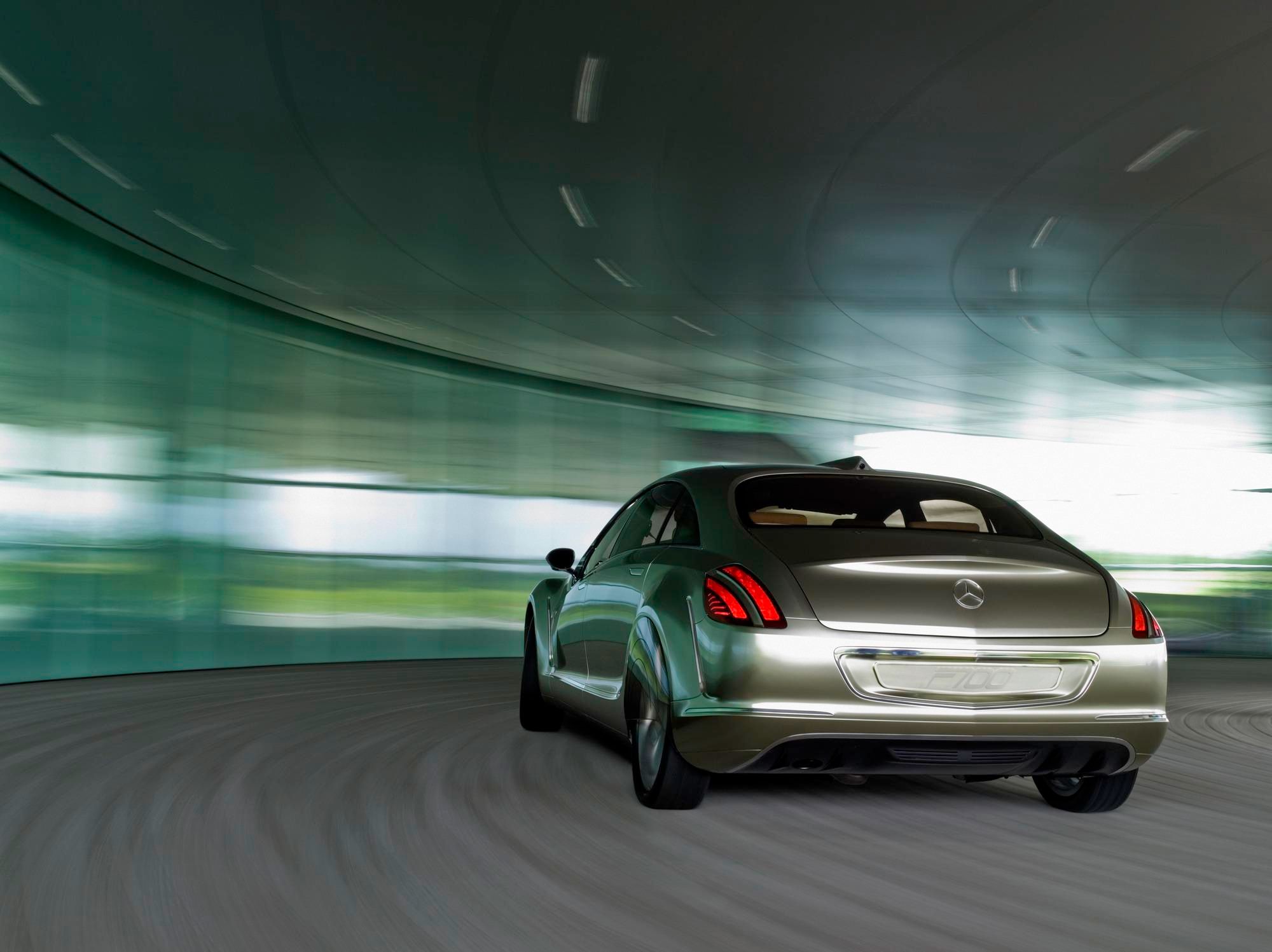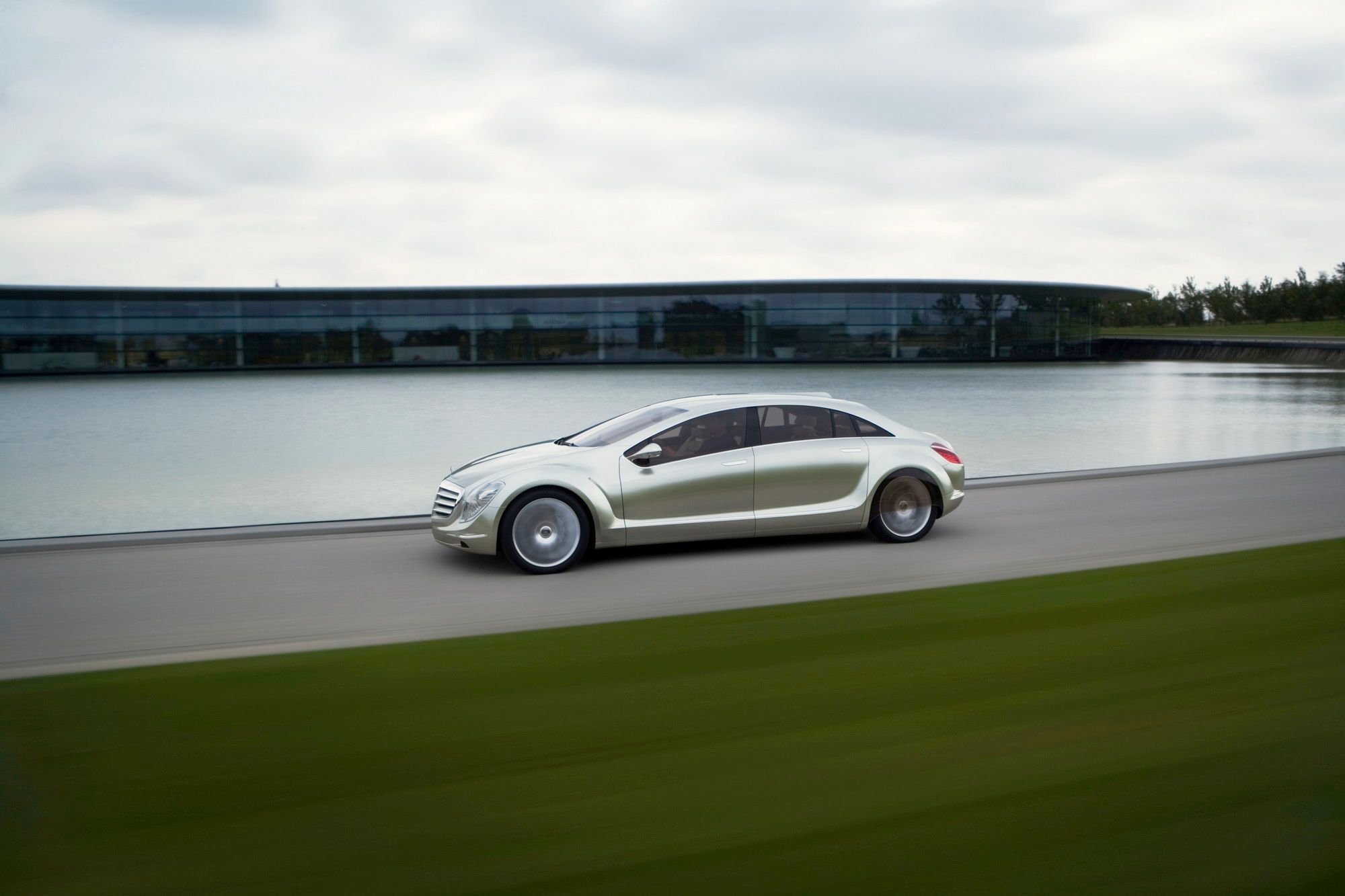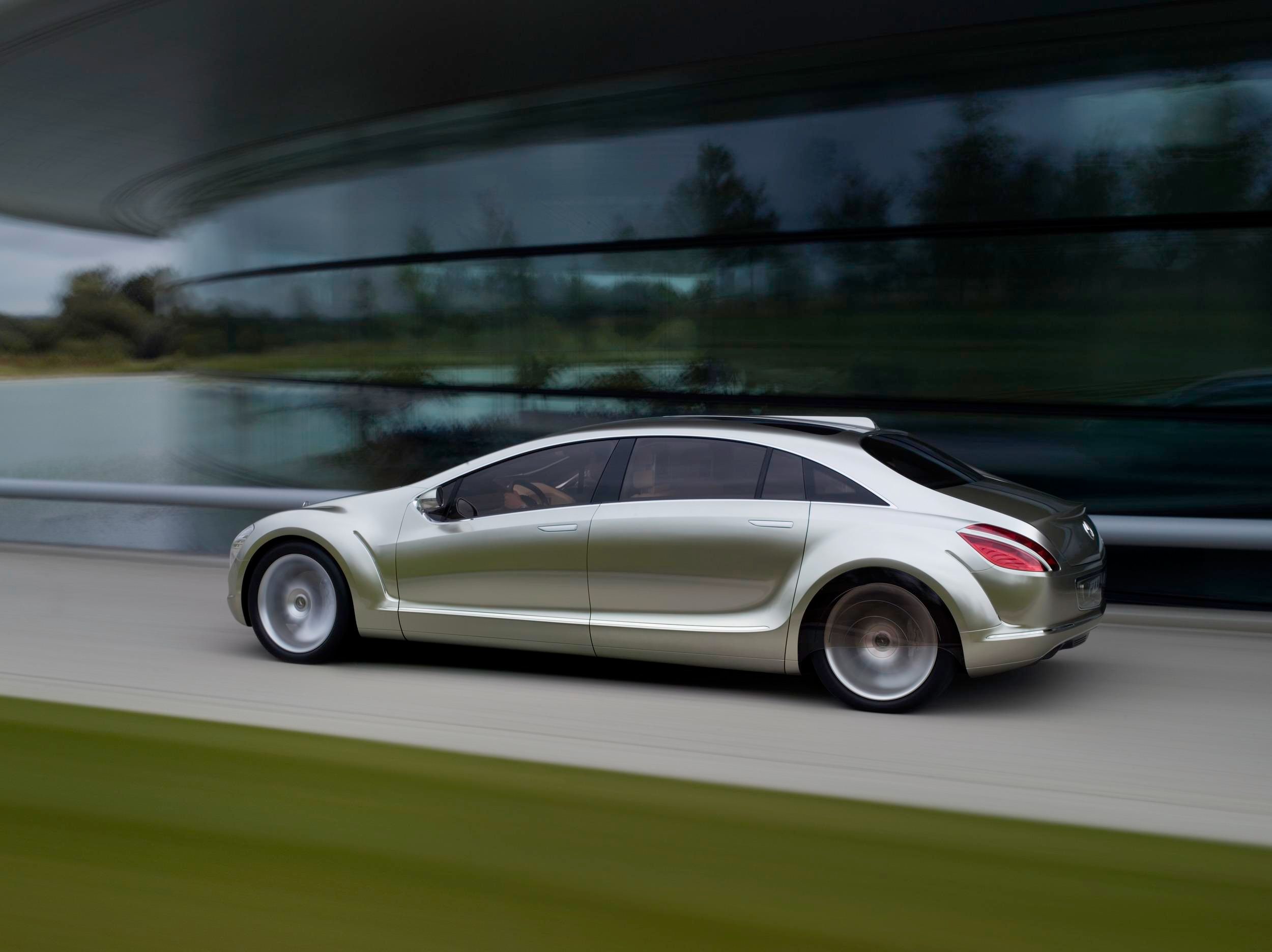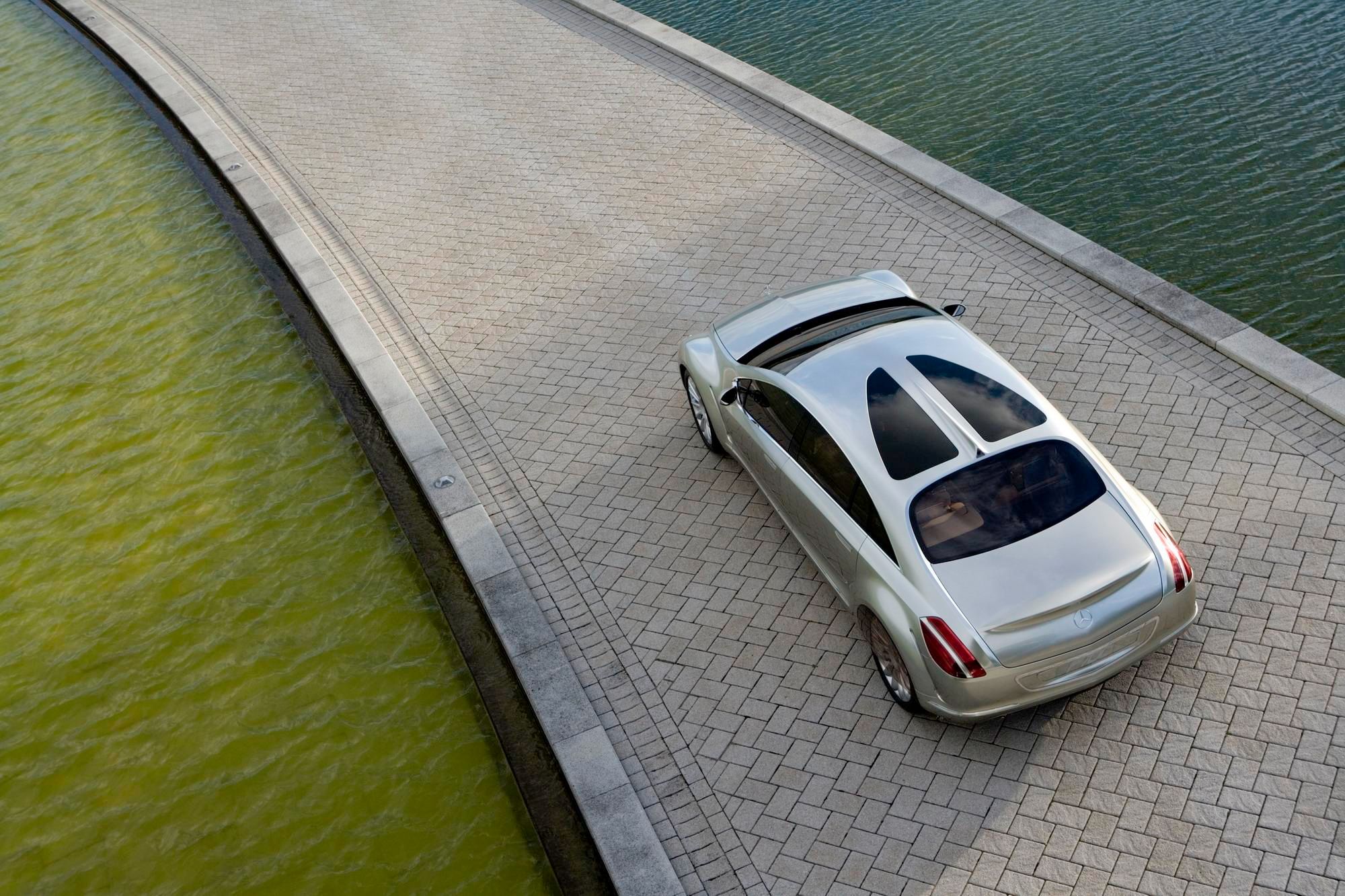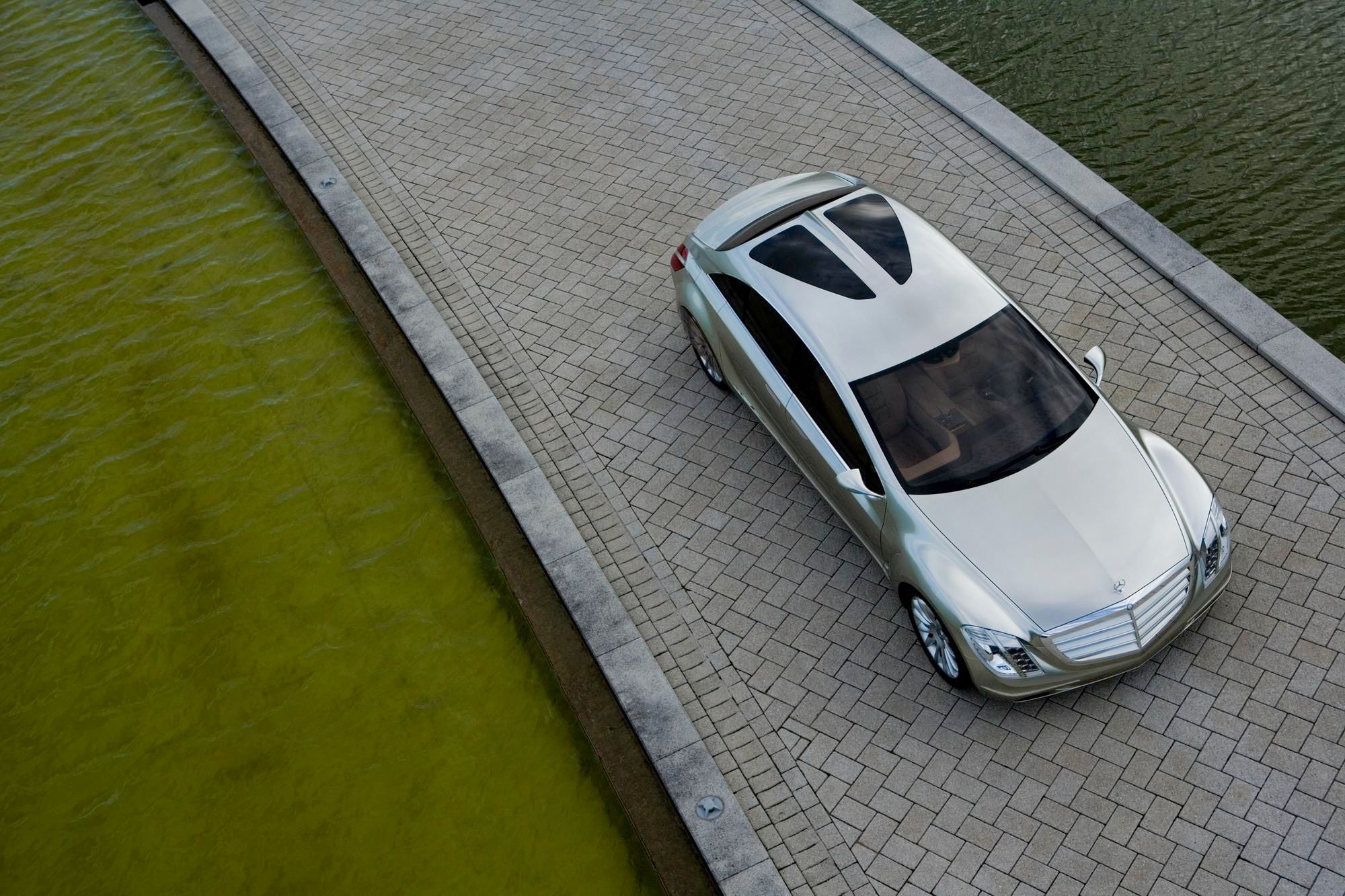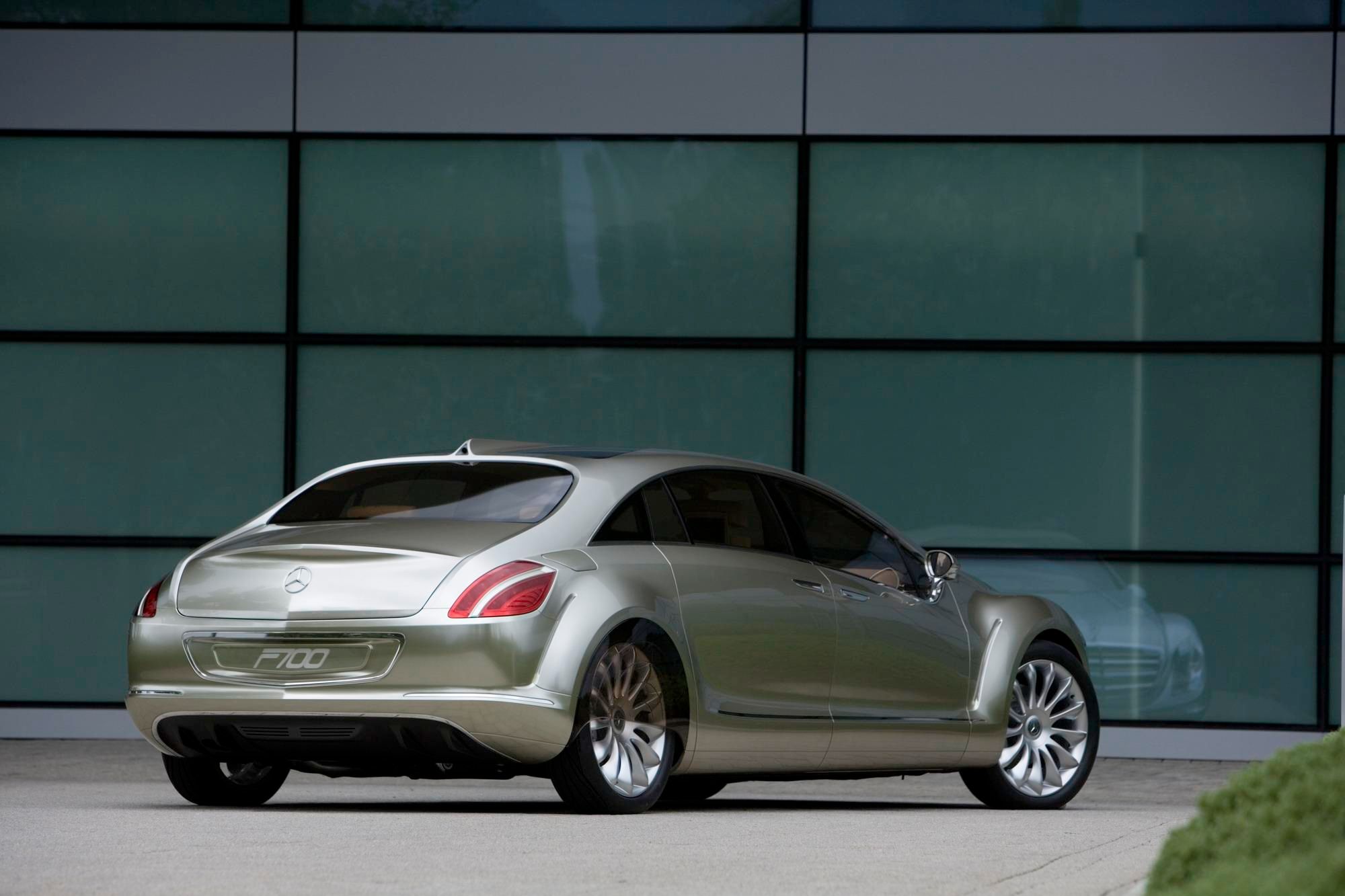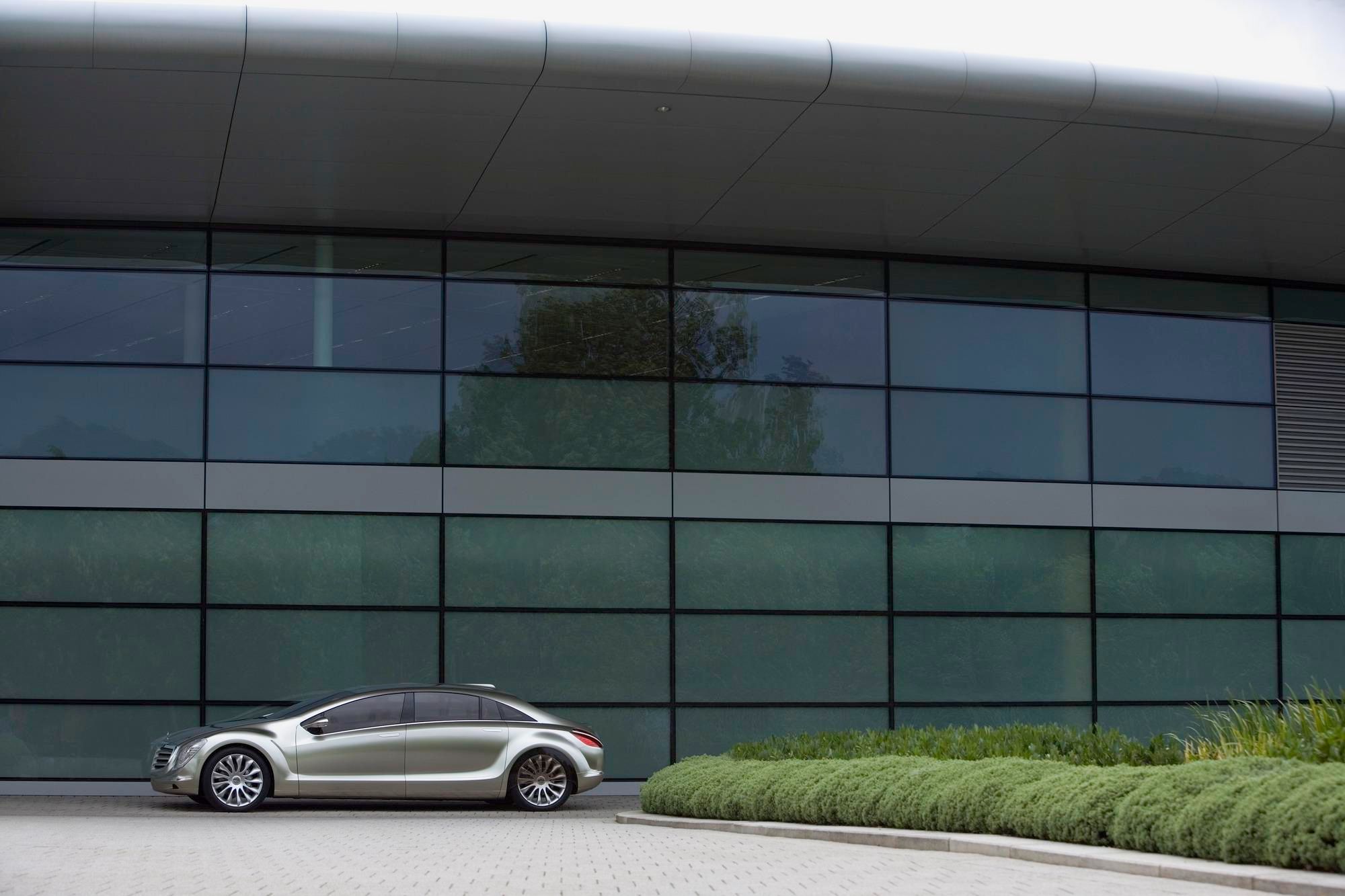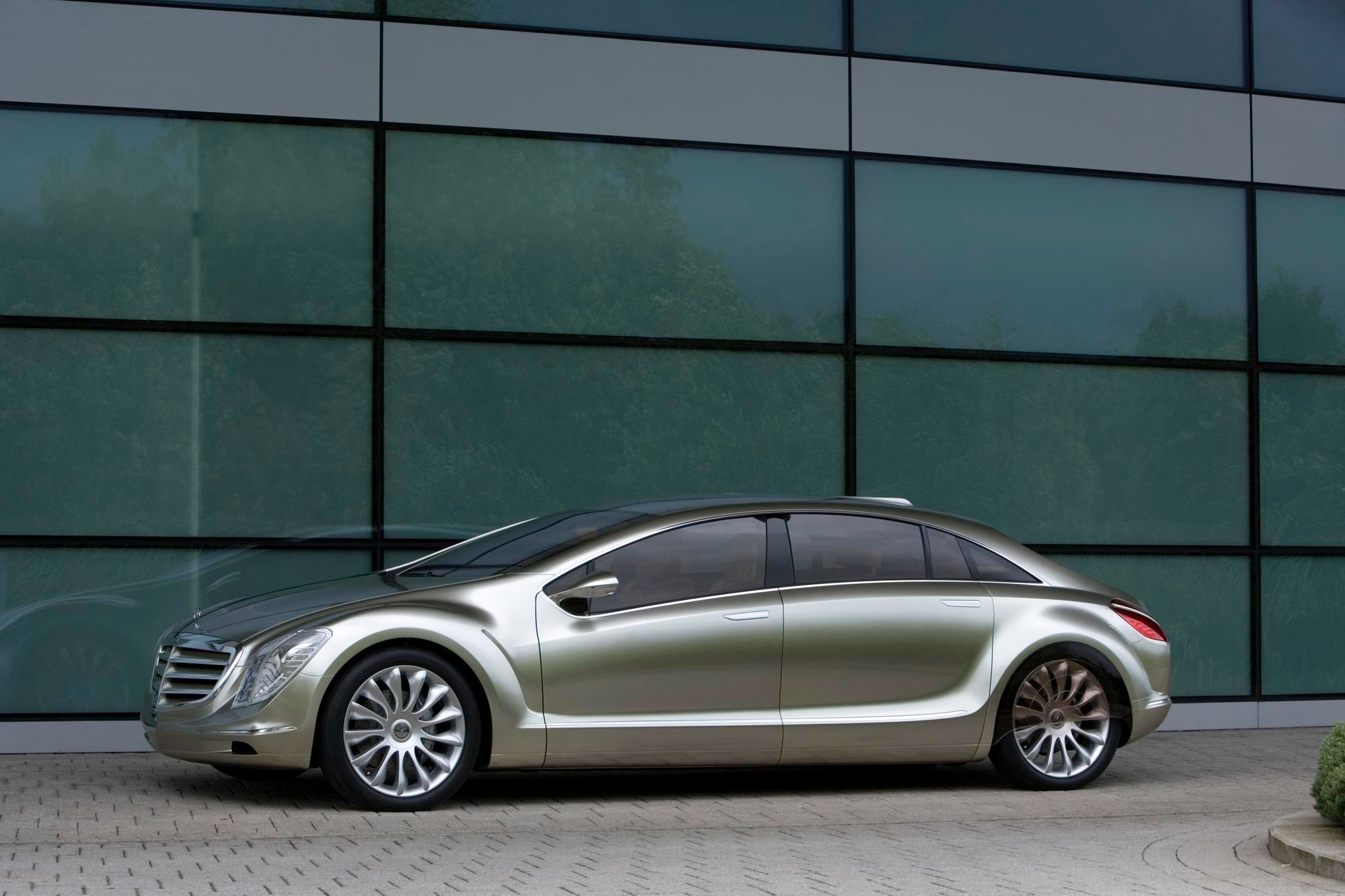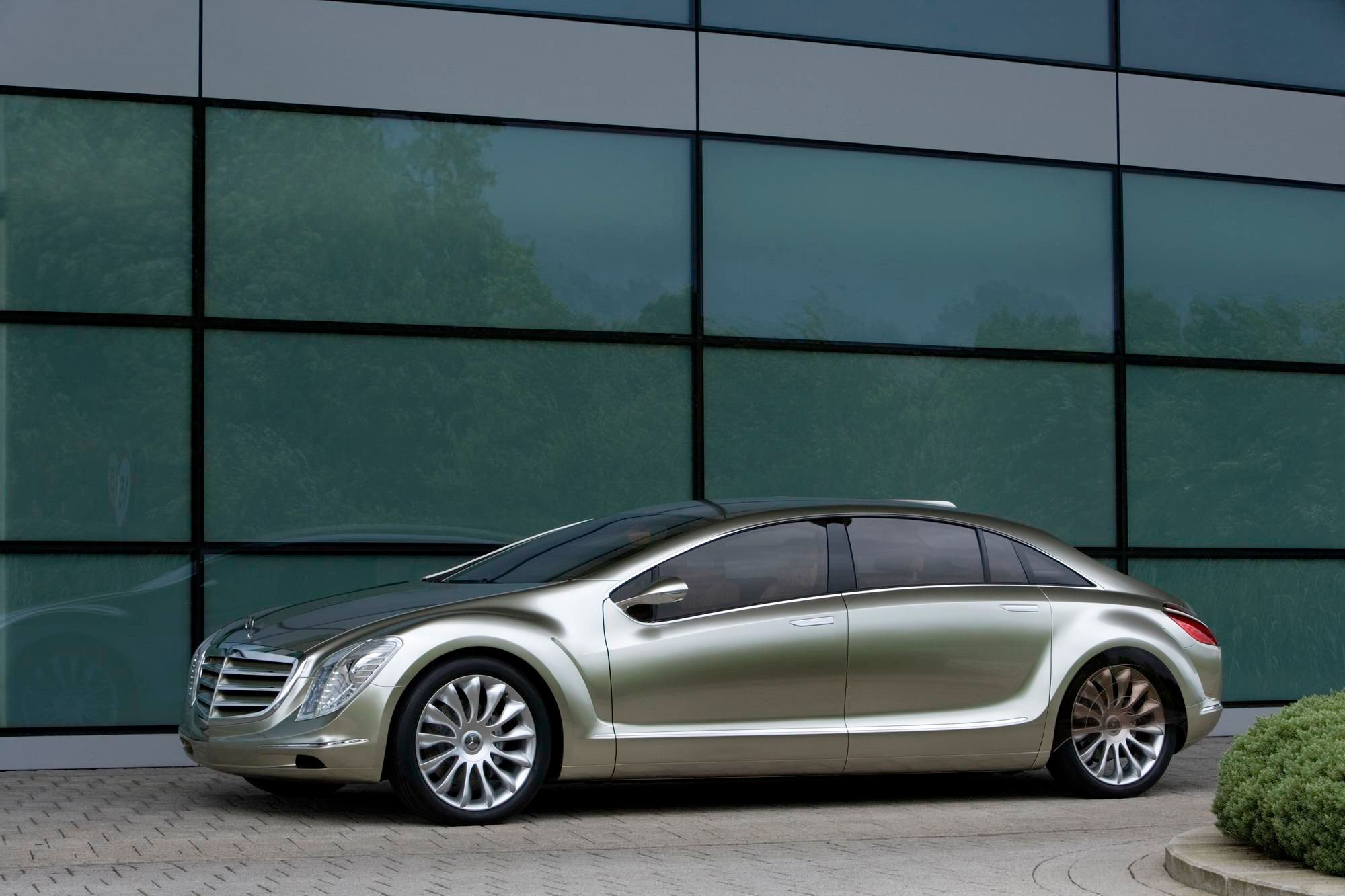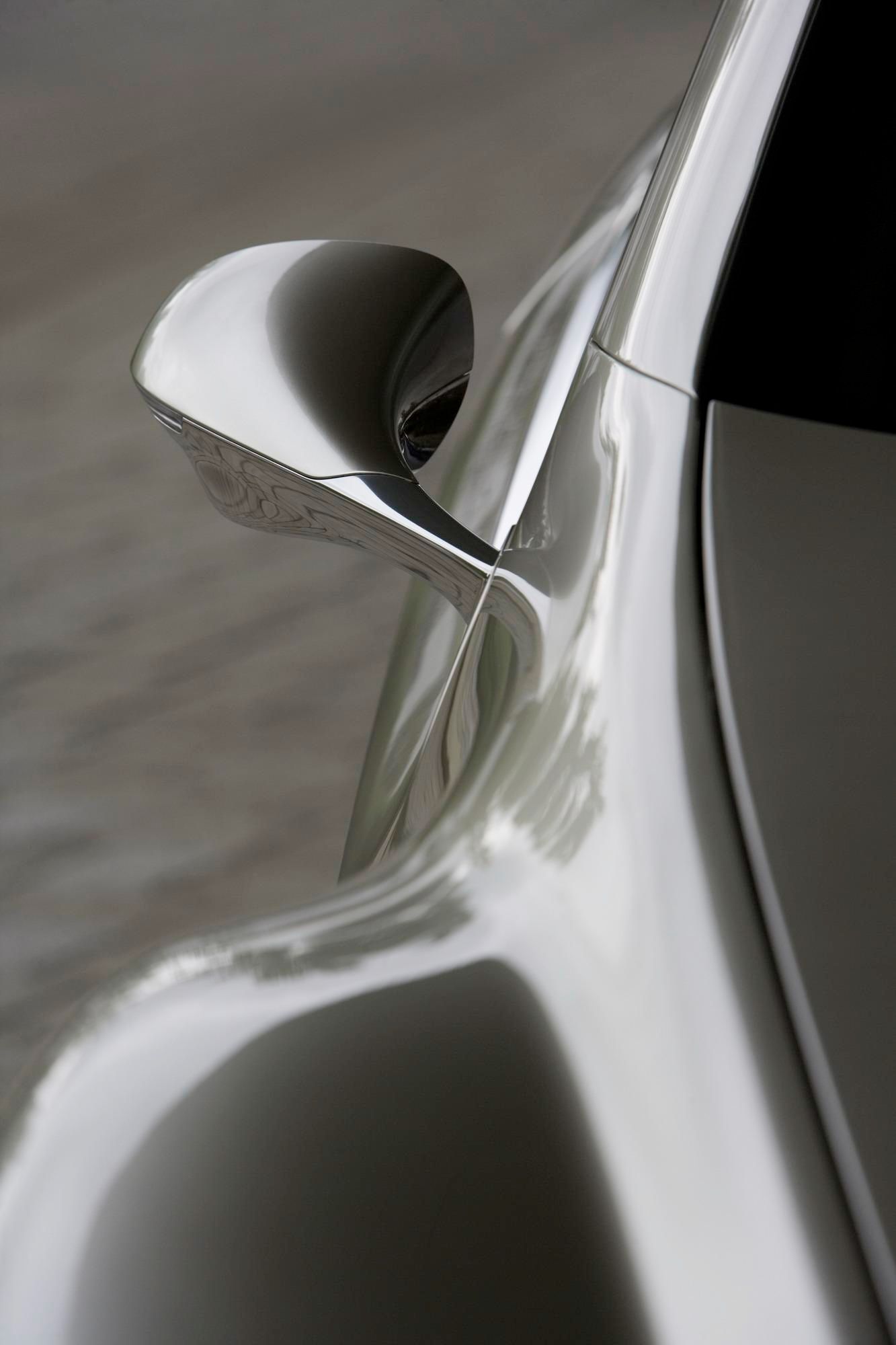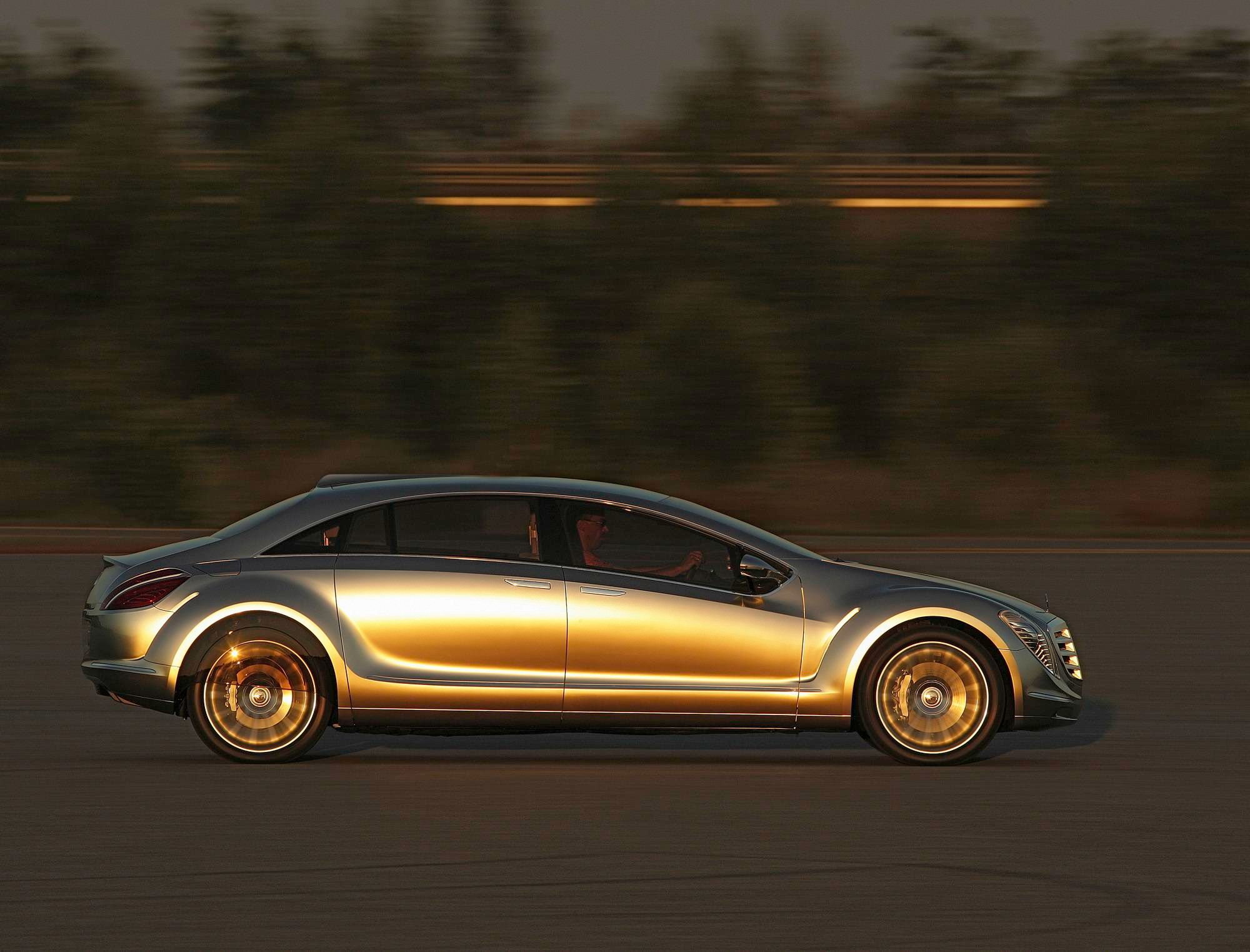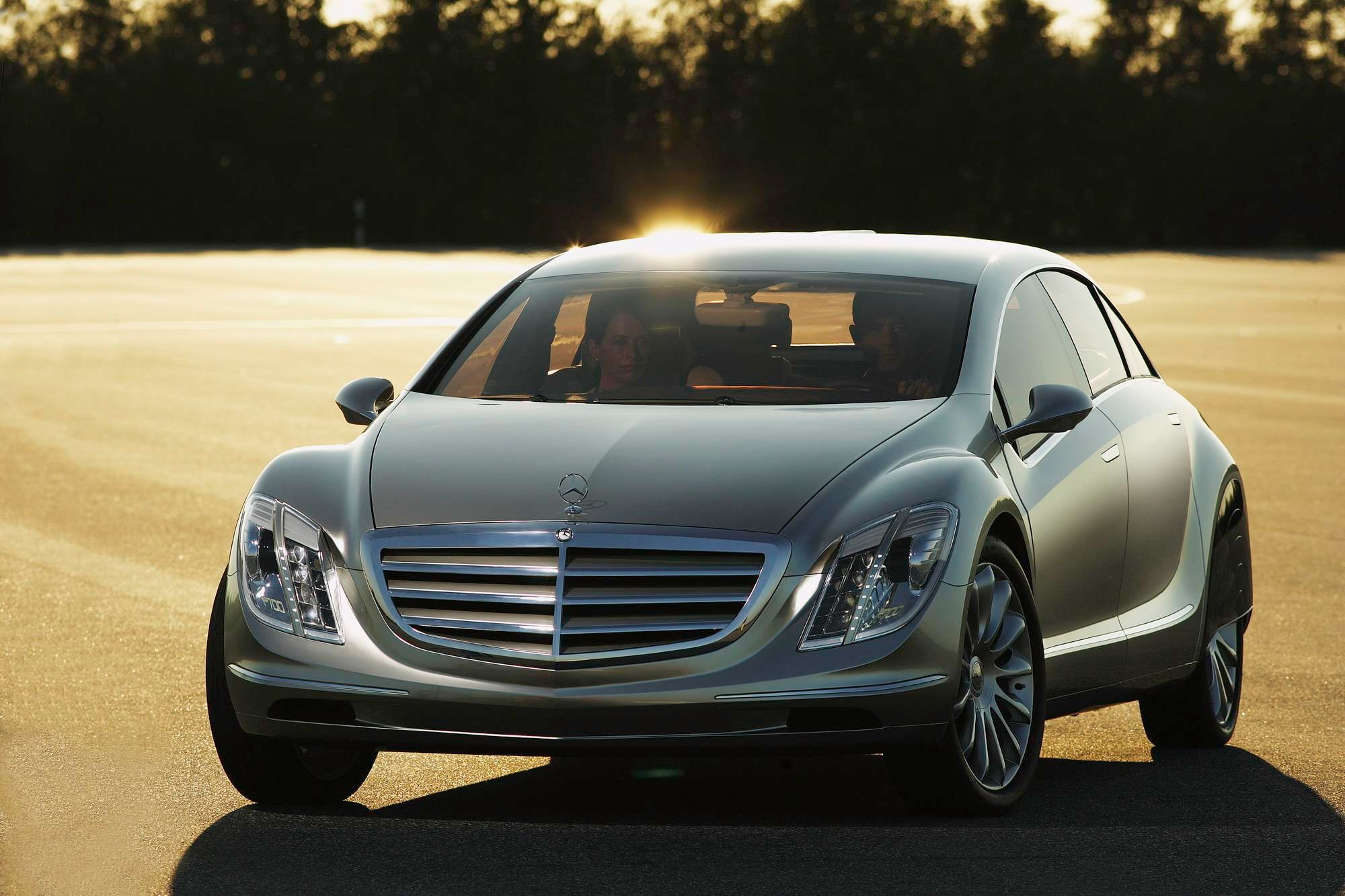With its F 700 research car, Mercedes-Benz redefines the idea of effortless, superior refinement: this concept for a future luxurious touring sedan shows how outstanding riding quality can be combined with high levels of environmental friendliness, and good performance with exceptionally low fuel consumption. Thus, the 5.17 meter long F 700 with its innovative and very spacious interior design enables an entirely new and exceedingly comfortable mode of travel.
2008 Mercedes F700
- Make: Array
- Model: 2008 Mercedes F700
- [do not use] Vehicle Model: Array
The F 700 is the world’s first car that can anticipatively recognize the condition of the road and level out the uneven spots with its active PRE-SCAN suspension, further improving suspension comfort substantially. The forward-pointing DIESOTTO drive system introduced in the F 700, a four-cylinder with a displacement of only 1.8 liters, combines the strong points of the low-emission gasoline engine with the consumption benefits of the diesel drive. Its CO2 emissions of a mere 127 grams per kilometer correspond to consumption of only 5.3 liters of gasoline per 100 kilometers (44.3 mpg), extremely low for a vehicle of this class.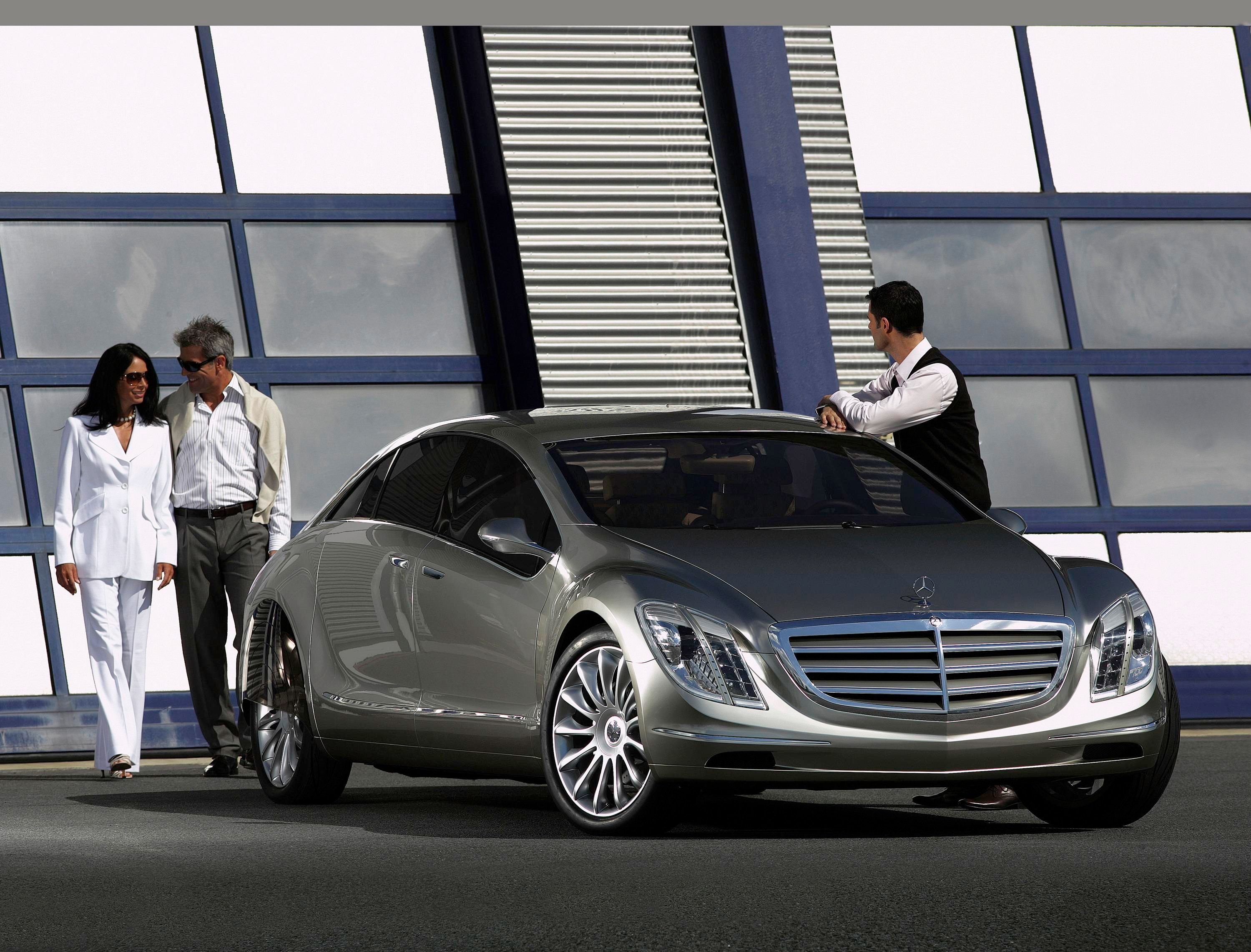 This is made possible by a forward-looking drive concept, the heart of which is the “DIESOTTO” technology – an advancement of the internal combustion engine thought up by Mercedes-Benz. With its novel controlled auto ignition (CAI), direct fuel injection and turbocharging, it combines the high power of the spark-ignition engine with the exemplary torque and great fuel economy of a diesel. The drive system in the F 700, as four-cylinder featuring two-stage charging, attains the performance level of a current S-Class car with a 3.5-liter naturally aspirated V6 gasoline engine or the 3.0-liter V6 turbodiesel.
This is made possible by a forward-looking drive concept, the heart of which is the “DIESOTTO” technology – an advancement of the internal combustion engine thought up by Mercedes-Benz. With its novel controlled auto ignition (CAI), direct fuel injection and turbocharging, it combines the high power of the spark-ignition engine with the exemplary torque and great fuel economy of a diesel. The drive system in the F 700, as four-cylinder featuring two-stage charging, attains the performance level of a current S-Class car with a 3.5-liter naturally aspirated V6 gasoline engine or the 3.0-liter V6 turbodiesel.
“Our goal is to make the gasoline-powered car just as economical in consumption as the diesel. The new DIESOTTO concept is a major step in that direction, combining the best properties of the spark-ignition engine and the diesel engine,” says Dr. Thomas Weber, Board member of DaimlerChrysler AG responsible for Group Research & Mercedes Car Group Development.
The F 700 also sets standards in regard to road roar, tire vibration and suspension comfort. With two laser scanners the active PRE-SCAN suspension scans the roadway in front of the car. The hydraulically controlled active suspension proactively compensates for detected hindrances, enabling entirely new comfort characteristics –a “flying carpet” feeling.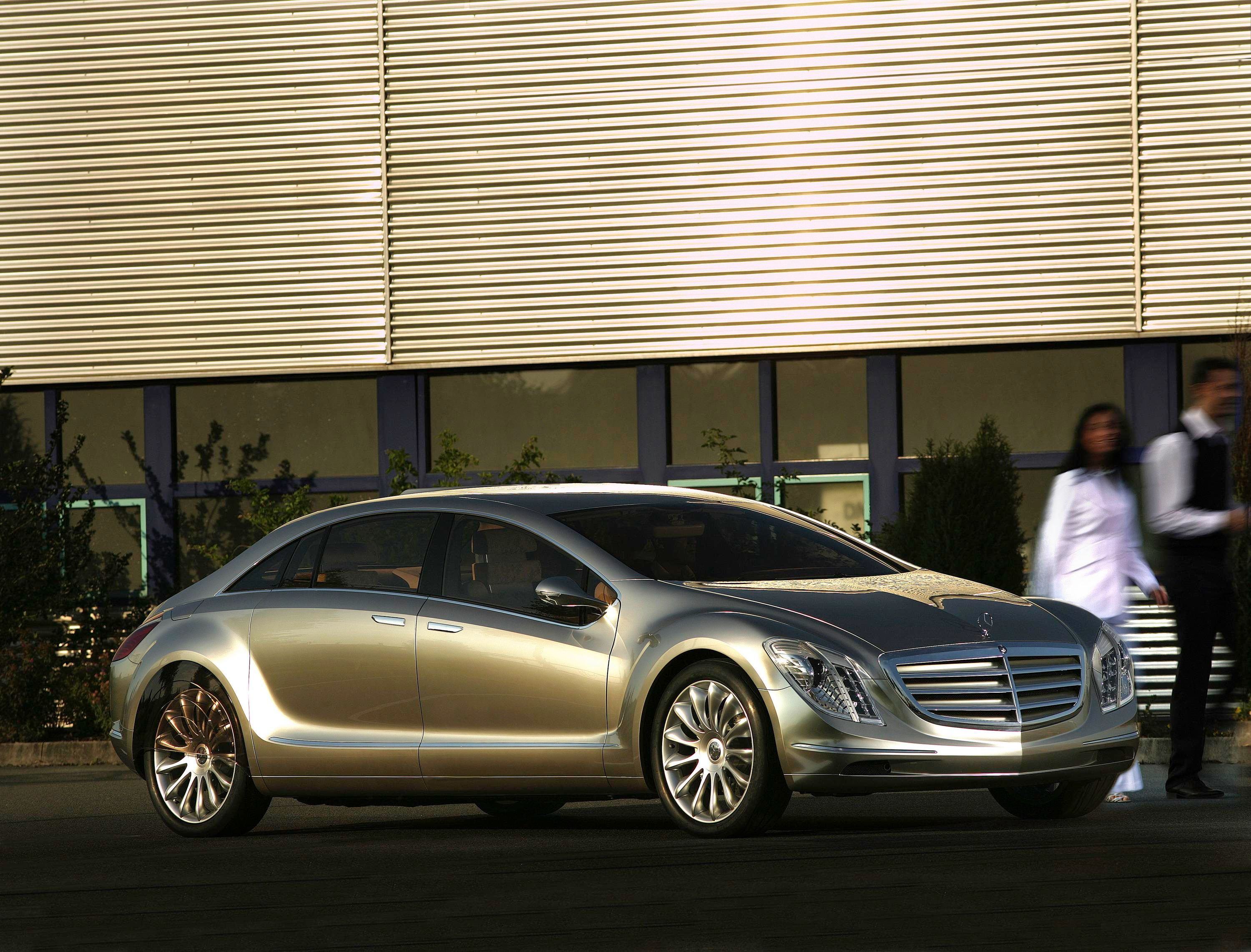 Equally innovative is the operating concept “SERVO-HMI”. The display is not only particularly gentle on the eyes; the number of controls also has been appreciably reduced and the menu structure has been made strikingly simple and self-explanatory. The driver can “discuss” more complex inputs, such as a destination for navigation purposes, in dialogue with an avatar, a virtual operating assistant.
Equally innovative is the operating concept “SERVO-HMI”. The display is not only particularly gentle on the eyes; the number of controls also has been appreciably reduced and the menu structure has been made strikingly simple and self-explanatory. The driver can “discuss” more complex inputs, such as a destination for navigation purposes, in dialogue with an avatar, a virtual operating assistant.
The exterior design of the F 700 shows that with this concept an extraordinary amount of space has been created for the passengers. The very silhouette, characterized by the long wheelbase, is a clear indication of this. The design harmoniously joins together inspirations provided by nature with technical innovation. All the futuristic styling devices notwithstanding, the F 700 is perfectly compliant with the brand identity of Mercedes-Benz.
The interior concept interprets comfortable travel and well-being in a completely new way. With its REVERSE seat the F 700 breaks up the firmly established seat arrangement of conventional sedans and offers individual seating positions facing, or with one’s back to, the direction of travel, always affording maximum spaciousness and supreme comfort.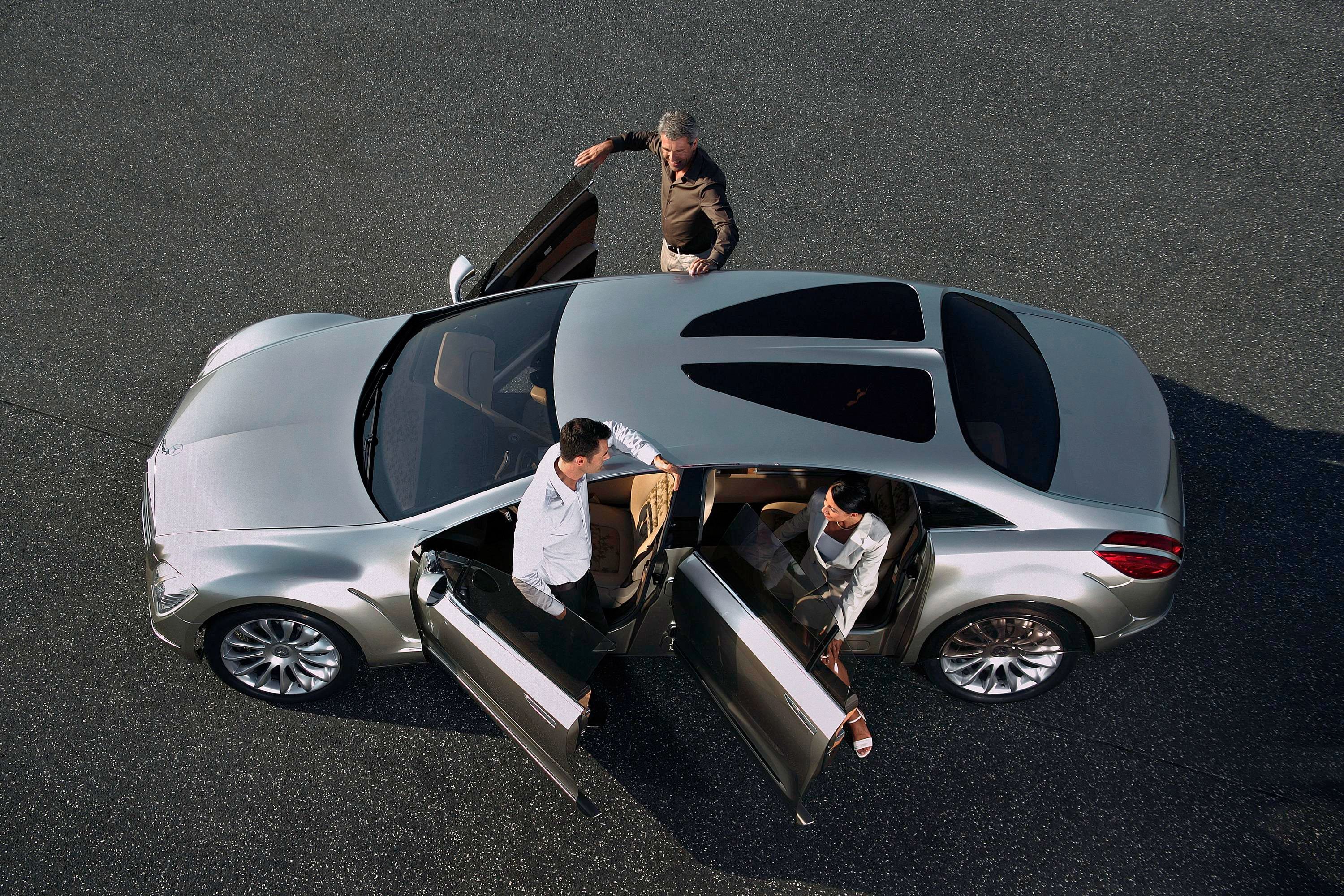 The F 700 provides inspiring ideas for the technological future of Mercedes-Benz once again – like each of the research cars which preceded it.
The F 700 provides inspiring ideas for the technological future of Mercedes-Benz once again – like each of the research cars which preceded it.
-----
The technology of the F 700
Individual mobility requirements will continue to rise worldwide in the coming years, particularly in countries with emergent economies. Mobility will remain the most important foundation for the successful development of the economy and society in the future.
Mobility will change in character. More and more people live in huge cities; more time will be spent on the streets and roads every day. This raises the demand not only for economical automobiles, but also automobiles which are comfortable and relieve driver stress as well as being safe, of course. Moreover, mobility increasingly will be determined by limited resources and the duty to treat the natural foundations of life gently. Most of all, consumption and emissions will have to be cut further.
Making mobility sustainable and compatible with humans and the environment is a responsibility to which Mercedes-Benz as inventor of the automobile has a strong commitment. Engineering spirit and innovative power are crucial, for intensive R&D alone gives rise to new technologies and opens up ways to new solutions.
The research car tradition of Mercedes-Benz documents the resolve and foresight with which the engineers from Stuttgart long have been dealing with the core topics of automotive engineering, developing innovative solutions for the future.
The F 700 thus shows new ways to a highly comfortable and at the same time resource-conserving mobility:
- The forward-looking DIESOTTO drive reduces the fuel consumption of luxury-class sedans to the level of compact cars.
- The active PRE-SCAN suspension raises ride comfort to previously unattained levels.
- The interior concept and the operating concept with SERVO-HMI guarantee relaxed travel even over the longest distances.
The DIESOTTO drive: A gasoline engine as economical as a diesel
An automobile’s fuel consumption is determined by a great many factors. They include weight, air drag and rolling resistance (tires), or the management of the many energy consumers in a vehicle. But the central and most crucial factor of all is the drive system. Enhancing engine efficiency remains the primary and decisive factor in cutting fuel consumption.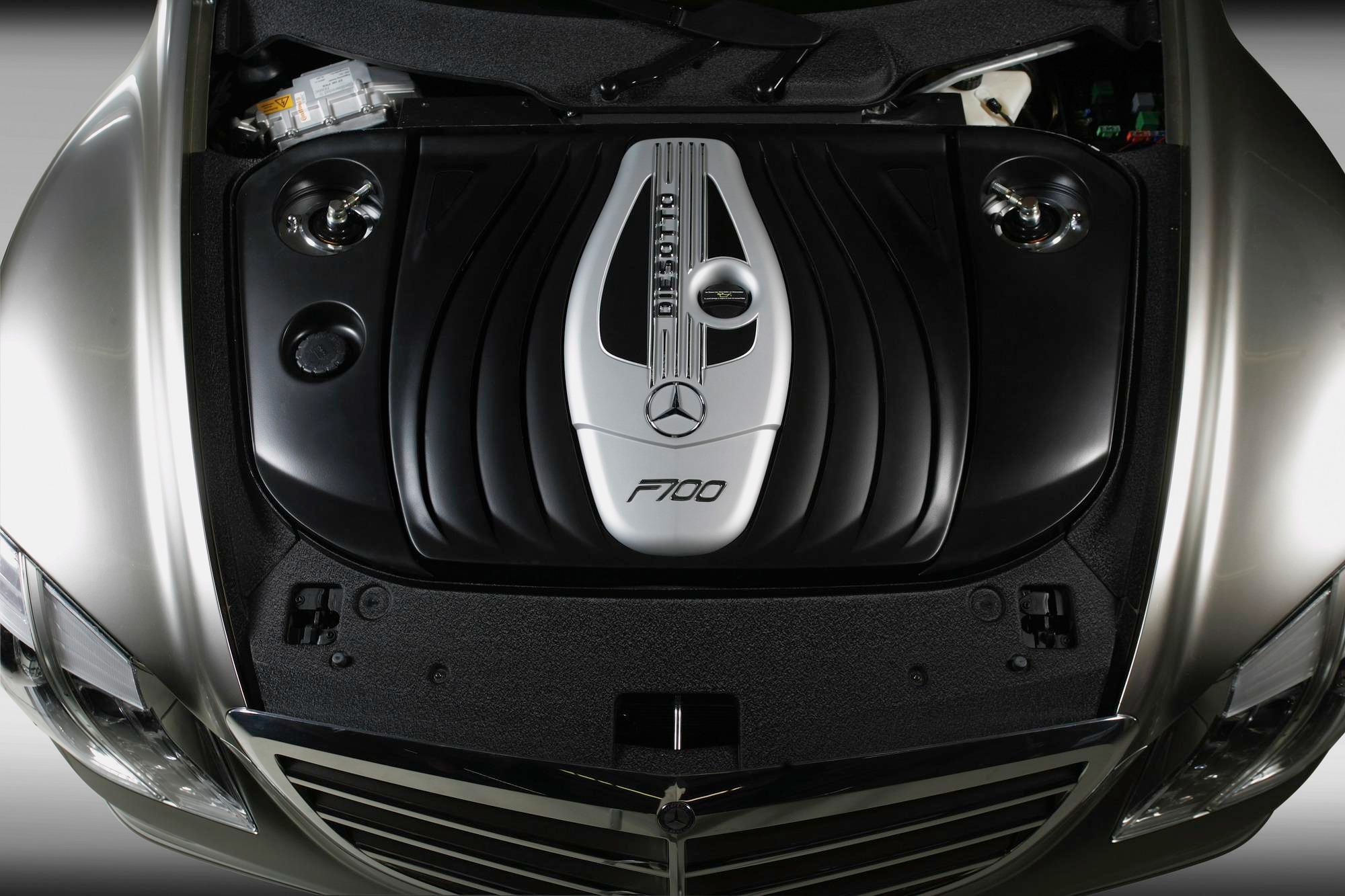 Mercedes-Benz is convinced that in the coming years, internal combustion engines will remain the dominant type of drive in automobiles – albeit appreciably improved in all dimensions. Depending on operating conditions and use profile, supplementing it with a hybrid module can be a sensible step. Mercedes-Benz offers a wide array of gasoline and diesel engines which can be complemented with different hybrid modules in the near future. So depending on field of use and personal preferences, every customer can select the drive which is the optimum for his or her purposes.
Mercedes-Benz is convinced that in the coming years, internal combustion engines will remain the dominant type of drive in automobiles – albeit appreciably improved in all dimensions. Depending on operating conditions and use profile, supplementing it with a hybrid module can be a sensible step. Mercedes-Benz offers a wide array of gasoline and diesel engines which can be complemented with different hybrid modules in the near future. So depending on field of use and personal preferences, every customer can select the drive which is the optimum for his or her purposes.
Until now gasoline and diesel engines have had clearly distributed roles: the diesel was more economical, but emission control was easier to manage in the gasoline-powered car. “Our strategic objective is to make the gasoline-powered car as economical as the diesel, and the diesel as clean as the gasoline engine,” says Dr. Thomas Weber, Board member of DaimlerChrysler AG responsible for Group Research & Mercedes Car Group Development. One part of this strategy already has been implemented: the BLUETEC technology, which reduces nitrogen oxide emissions, gives the diesel engine the capacity to comply even with the world’s harshest emission standards – including those to come in future. BLUETEC is already on the market in the and will be available in from the end of 2007.
“Researchers and developers need challenges and great goals,” says Dr. Thomas Weber. “For this reason we think much farther ahead at Mercedes-Benz: we are going to combine the strengths and advantages of both combustion principles in one innovative engine concept. The DIESOTTO drive is a major step forward.”
Unique system for reducing consumption
The DIESOTTO drive in the new research car is a unique, integrated system for consumption reduction.
It involves
- downsizing by reducing cylinder size and smaller displacement;
- turbocharging;
- direct gasoline injection;
- variable valve control;
- controlled auto ignition (CAI);
- hybrid module with integral starter-generator.
DIESOTTO brings the benefits of diesel technology to the gasoline engine: in the CAI mode the air-fuel mixture ignites itself the same as in a diesel engine. And yet DIESOTTO makes no special demands on fuel quality: the engine runs on normal gasoline.
Controlled auto ignition, moreover, not only is more economical than the conventional combustion triggered by a sparkplug, it is also cleaner as regards emissions. In controlled auto ignition, as the Mercedes-Benz engineers term their new process, hardly any nitrogen oxides (NOx) are produced. DIESOTTO thus points to the future of the gasoline engine – a future imagined, researched and developed by Mercedes-Benz.
Two-stage charging and hybrid module
The first step to less consumption is to downsize the engine. Instead of a big-volume, naturally aspirated engine, a compact, turbocharged power plant is used. This leap backwards in cylinder size and displacement reduces internal friction in the engine. The smaller unit increasingly runs in a more efficient combustion range. The drive system in the research car is a four-cylinder with a displacement of a mere 1.8 liters. At first, this is somewhat of a surprise for a vehicle of the luxury class, where up to now at least six cylinders and three liters displacement are the standard.
The sensation of effortlessly superior driving in the luxury class nonetheless is retained. The DIESOTTO drive gets additional power from a two-stage turbocharger system. A larger low-pressure turbocharger and a high-pressure turbocharger of smaller diameter are connected in series and together optimally cover the complete engine speed range. The complex system makes for good responsiveness from low revs, provides high torque and pulling power and delivers high peak output. For driving off, the internal combustion engine additionally gets assistance from the electric motor of the hybrid module.
The maximum output of the internal combustion engine is 175 kW (238 hp); the electric motor develops another 15 kW (20 hp); the maximum torque of the system is impressive 400 Newton meters. This guarantees performance commensurate with the luxury class, as the time of 7.5 seconds for the 0 to 100 km/h (62 mph) sprint documents.
The hybrid module with its integral starter-generator helps to even further reduce the excellent fuel consumption mainly in urban stop-and-go operation. The internal combustion engine always is shut off when it is not needed. On moving off, the combination of internal combustion engine and torquey electric motor is a tandem that ensures a powerful but silky smooth start. Besides that, during coasting and braking the electric motor recovers energy which is stored in a special high-voltage battery and used for the next starting operation. This starter-generator is integrated in the housing of the 7G-TRONIC automatic transmission.
Direct injection and variable valve lift
The next, decisive element in the DIESOTTO system is direct injection. With the CLS 350 CGI, Mercedes-Benz has pioneered second-generation spray-guided gasoline direct injection. Compared with conventional manifold injection this technology provides a consumption advantage of some ten percent, among other things due to lean-burn operation at partial load.
In the DIESOTTO engine direct injection is used differently than in the CGI engine, which in lean-burn operation needs an ignitable mixture cloud around the sparkplug. DIESOTTO operates with a lean mixture, but needs direct injection for a homogeneous mixture in the cylinder and for the free control of the injection cycles.
Another component is variable valve control. The valve opening times can be adjusted over a large range, and the valve lift can be altered too. To achieve this, the camshaft is provided with two cams, a smaller one and a larger one, for each valve. The large valve lift is needed for full-load operation and high engine speeds, the small valve lift mainly for CAI at partial load.
Variable crank mechanism
In order to meet the different requirements for partial and full-load operation, the DIESOTTO engine is fitted with a variable crank mechanism with which the geometric compression can be continuously adjusted. So despite high specific output an economical drive system can be realized.
Path-breaking new combustion cycle
The consumption advantage results mainly from the relatively lean mixture and high exhaust gas content, and from adaption of the compression ratio depending on operating point. The low emissions of nitrogen oxides are a result of homogenous combustion at a constant, relatively low temperature. Nitrogen oxides are caused by temperature peaks which are hardly avoidable in conventional, sparkplug-initiated combustion. For further emission control a common three-way catalytic converter is perfectly adequate for the DIESOTTO drive. This enables compliance also with future more severe emissions standards.
Great engineering skill enables the most accurate control
The high art of engineering applied to the development of DIESOTTO is manifested in the combination of the individual technologies and their control. Uniting them is the prerequisite for an application with practical qualities.
CAI is suited for the most frequently used driving modes, at low and intermediate speeds as well as for intermediate load requirements. At higher loads, DIESOTTO switches to conventional combustion within a single power stroke. In this case it breathes using the large valve lift, fires using sparkplugs and runs as a direct-injection unit in Lambda1 mode.
This preview of the future of the internal combustion engine illustrates the great potential and shows that the new drive concept is capable of being realized in the medium term. Some of the incorporated partial solutions, such as gasoline direct injection, already are in production at Mercedes-Benz. Others will enter into production engines step by step until the complete solution is implemented.
Active PRE-SCAN suspension – another milestone on the way to “flying carpet” comfort characteristics
The most important requirement made on a luxury-class sedan is relaxed and comfortable travel. A high riding quality and high suspension comfort substantially contribute to conserving the individual resources of the driver and his or her companions. Mercedes-Benz is world leader in the area of road roar and tire vibration suppression and suspension comfort: in the Active Body Control (ABC) suspension system, the current models of the S-Class and CL-Class already offer a high-end solution embodying advanced suspension technology.
The F 700 suspension provides an indication of the next major steps towards the future: the newly developed active PRE-SCAN suspension improves the sensitive response to surface unevenness as well as the active stabilization of body movements, raising them another notch.
The best combination of comfort and safety
The development of a conventional passive suspension setup always is like striving for the best compromise: Sporty-taut tuning reduces wheel vibrations caused by the road, but after a time becomes relatively uncomfortable. Making the springing and damping too soft, on the other hand, will introduce an uneasiness into the suspension and body and result in drawbacks for directional stability and road adhesion as well as handling dynamics.
Active Body Control
For the F 700 research car the Mercedes-Benz engineers have appreciably improved on this system: from various acceleration sensors the system’s control unit gets information about the driving situation at any time and compares it with the data of the pressure sensors in the ABC hydraulics and the data of the level sensors on the control arms.
Stabilization within a fraction of a second
Owing to constantly available hydraulic pressure, this active suspension is capable of stabilizing the body within a fraction of a second. Conventional spring elements and damping throttles take care of the higher-frequency vibrations and wheel damping. By combining them with the controls of the Active Body Control, their setup can be made especially comfortable and highest handling safety ensured.
Another comfort function is incorporated into the active suspension of the F 700: For particularly convenient entry and exit or for driving on very rough roads which call for more ground clearance, the actuators of the ABC suspension can raise the body by as much as 80 millimeters.
Laser sensors scan road
The PRE-SCAN function enhances the active suspension with a unique information channel: it permits adjusting the control strategy for uneven stretches lying ahead of the vehicle. For this project the Mercedes-Benz engineers again were inspired by nature. When uneven spots are detected, with PRE-SCAN the car computes the suitable control strategy in advance and adapts its systems to it.
The “eyes” of the active PRE-SCAN suspension are two LIDAR sensors. LIDAR stands for “Light Detection And Ranging” and describes a method for measuring distance which is very closely related to radar. The sensors send out pulsed laser beams in the infrared range, detect the reflected light and compute the distance based on the propagating time.
Uniquely intelligent suspension
The suspension operates using two sources of data: the laser sensors provide signals indicating the run of the road surface and the vehicle sensors add information about the current driving condition. From both sources the control unit computes the best strategy for overcoming an obstacle. As a result, in advance the vehicle can make the damping of the Active Body Control firmer or softer for each wheel, individually, and put load on or relieve load from the wheel by means of the active hydraulics.
Tires with very low rolling resistance and high potential for reducing CO2 emissions
The Mercedes-Benz F 700 rolls on tires developed specifically for the concept car by Michelin. The size 195/55 R 21 tires are distinguished by low rolling resistance as well as high riding quality and quiet running. They are an optimum complement to the advanced drive and suspension concept of the technology car.
With the tire study specially developed for the concept vehicle, Michelin resolves the conflict of goals between low rolling resistance and refined rolling characteristics. The large diameter of 21 inches and the pronounced sidewall height make for optimum comfort and low tire noise. The tire width of a mere 195 millimeters in conjunction with a tread made entirely of a silica-reinforced blend of rubber ensures outstandingly low rolling resistance: rolling resistance is about 17 percent less than with conventional car tires, which reduces fuel consumption and CO2 emissions. Another effect of the high silica content: the tire quickly reaches its optimum operating temperature and thus affords a high level of safety even on wet roadways.
The control and display concept: Innovations for simple, intuitive operation
Luxury-class sedans preferably are used for traveling long distances. Ensuring comfort and stress-relieving safety for the driver and passengers is their first priority. The F 700 conserves the resources of its occupants in exemplary fashion: along with the spacious and variable interior concept and the completely new degree of suspension comfort, the innovative display and control concept conduces greatly to relaxed travel.
Human-Machine Interface – HMI for short – is the technical term for a development task to which Mercedes-Benz devotes great effort. It concerns the best possible adaptation of technology to human beings and involves an operating concept that makes technical things easily, reliably and intuitively controllable. It should offer the driver maximum information and individually selectable settings while minimizing distraction.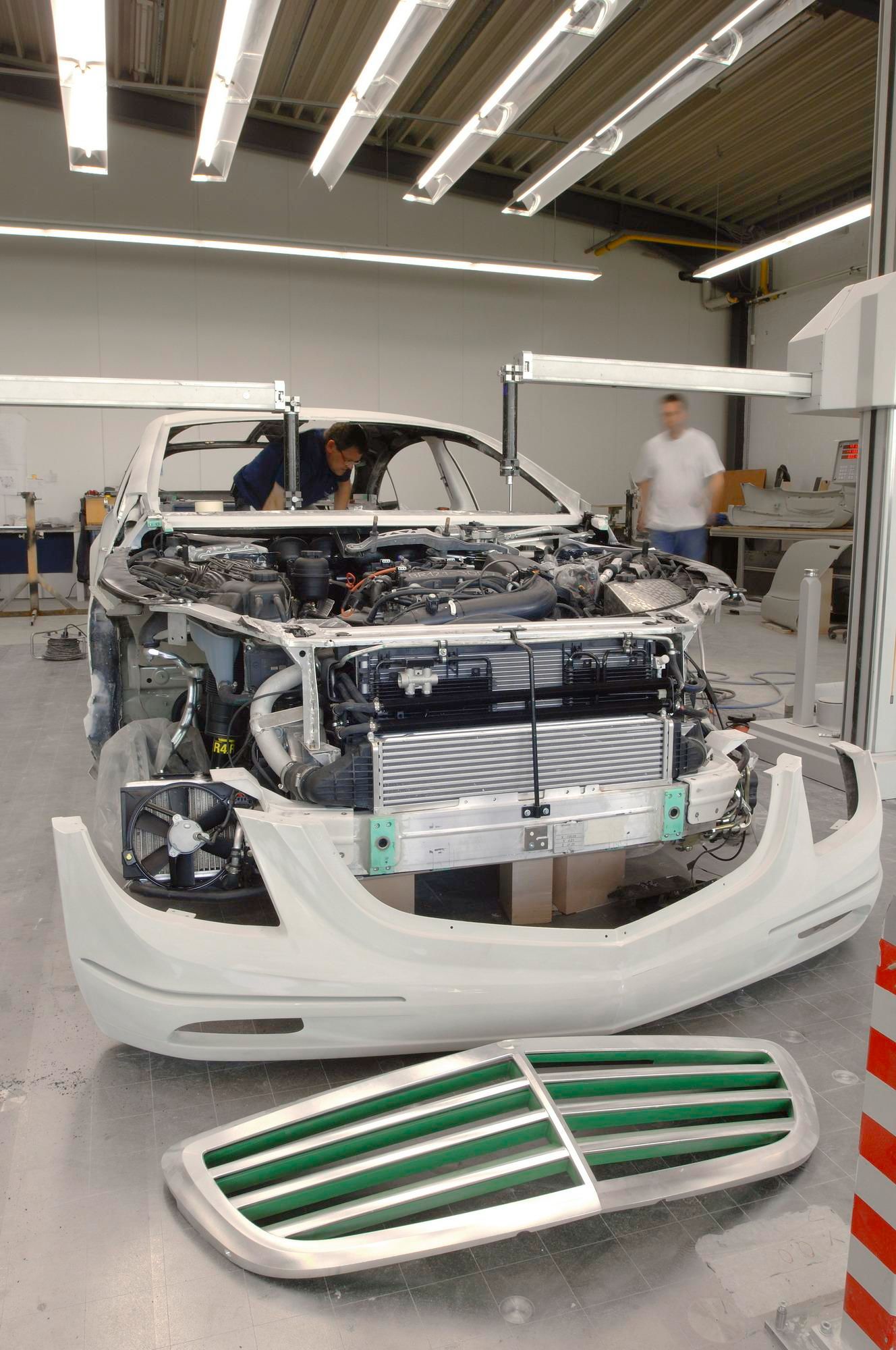 For the F 700 the Mercedes-Benz engineers have developed an entirely new display concept and further developed the proven COMAND control concept, incorporating a whole range of pioneering innovations. They include:
For the F 700 the Mercedes-Benz engineers have developed an entirely new display concept and further developed the proven COMAND control concept, incorporating a whole range of pioneering innovations. They include:
- SERVO-HMI reduces eye fatigue by extending the viewing distance.
- Voice recognition with a virtual operating assistant (avatar) for facilitating control of complex functions by means of a verbal dialogue.
- Reduction of control functions through increased automation.
- The rotary/pushbutton controller with added slide function.
- The entertainment system with Roadview and three-dimensional cinema.
This innovative glimpse of the future is based on the optimum operating concept of the present: the established COMAND system in the current models of the S-and CL-Class.
Mirror display easy on the eyes
One of the major fatigue factors on long journeys is so-called eye accommodation. This refers to the adjustment of the eyes when vision frequently changes from close range to long range, i.e., from the near cockpit display to distant traffic. The eye needs muscle power to effect this change in focusing planes, especially for objects which are very close.
As a contribution to stress-relieving safety the research engineers have developed the SERVO-HMI for the F 700. The driving and vehicle information which it displays appears at the bottom edge of the windshield but, optically, appears a bit further away, because at the point farthest forward in the vehicle interior there is a mirror; the display itself is horizontally retracted into the cockpit. Accordingly, the viewing distance is the sum of the path from display to mirror and the path from the mirror to the driver’s head. So when viewing the displays the eyes no longer have to shift from far to near vision to the extent usually required today, and therefore are subject to much less strain – a tangible contribution to driving safety verified by scientific studies.
Assistance systems like DISTRONIC PLUS and the trip computer and vehicle functions are operated by means of the scroll wheel on the left of the steering wheel. The researchers have devised a very simple menu involving only a few steps. The F 700’s designers were particularly thorough in the way they reduced the operating functions for the lights and windshield wipers. Both are controlled fully automatically: perfected rain sensors and ingenious driving light sensors render conventional switches for these functions superfluous. The same can be said of the defrost position of the automatic climate control or the rear window heater. Here, too, the conventional switches have been replaced by a sensor-controlled automatic mechanism.
The control system presents itself in thoroughly improved form and is supplemented by a very graphic assistant. Instead of a separate screen the right-hand third of the very wide SERVO-HMI is used for it. The driver thus also profits from the eye-sparing advantages of this display technology when he looks at the navigation map or the list of radio stations.
Reduced menu levels, simple input
The control system in the SERVO-HMI controls three function groups: navigation, communication/telephone and audio/entertainment. The unit is operated by a rotary/pushbutton controller on the center console. The primary goal of the developers was to reduce the menu levels and the individual menu items without cutting back on the functions. An additional controller function has eliminated one menu level: to shift between the three main groups one only has to slide the controller forwards or backwards.
Conventional menu items have been furnished for selecting simple functions. For more complex inputs there is an innovative assist function: the individual input assistant in the shape of a virtual person called an avatar in computerese. Avatars, as electronic images representing real persons, are familiar from the internet world or computer games.
Chatting with your assistant
The avatar in the control system of the F 700 takes the shape of a young woman, but depending on country and culture other assistants also can be realized. The virtual person enters into contact with the driver through a voice dialogue. In the menu item navigation, for example, it asks for the desired destination. The driver states the town and street, or simply a name from the system address book. The avatar confirms the input and the route is computed. Selecting someone to talk to from the phone book or a desired radio station functions in a similar way.
The coupling of voice recognition with the dialogue system and individual menu items has big advantages: Since the virtual assistant unambiguously polls the required information, the driver does not need to remember specific voice commands. Conversely, voice recognition works more reliably since the system knows the context of the words being spoken.
The scope of assistance functions later can be enlarged almost without limit. For instance, the avatar as virtual assistant could access online databases from the vehicle via internet link and, let us say, get the addresses and phone numbers that go with certain names, could update the driver’s appointments book, or could read aloud important e-mails. Operation by voice dialogue minimizes distraction, for it goes without saying that driving safety always has priority for Mercedes-Benz.
The control recognizes the user
Climate-related well-being is an essential element of the sense of comfort aboard an automobile. An unobtrusively regulated, draft-free automatic climate control is thus an obvious equipment feature. The unit is operated by a separate rotary/ pushbutton controller on the center console.
Here again simplicity is the overriding principle: the control therefore automatically recognizes whether it is being used by the driver or front passenger and, accordingly, activates the climate control for the left or the right side. The SERVO-HMI display immediately shows, as first level, the activated temperature for the side of the vehicle concerned; the detailed settings are made through a menu level. Here, too, the user prompt from the current S-Class was developed further.
The novel user recognition is based on skin effect transmission: as soon as the front passenger, for example, touches the central rotary/pushbutton controller, a contact is closed between the control and a sensor mat in the seat upholstery and switches the control of the air conditioning for the front passenger side. The individual settings for the rear passengers are made by means of controls in the rear doors.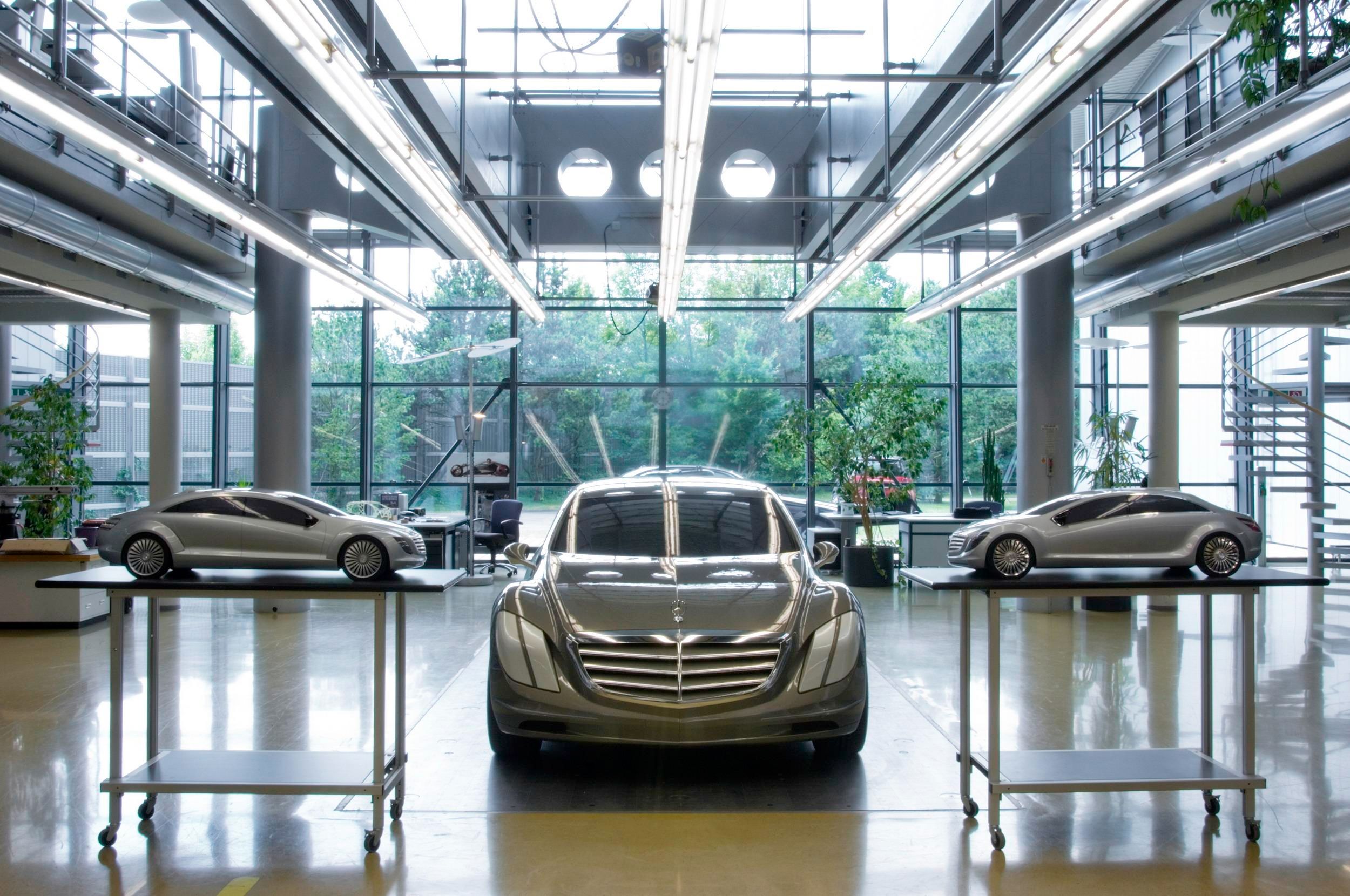 The innovative Human-Machine Interface of the F 700 has minimized the number of controls in the cockpit despite numerous new functions – to the delight of the interior designers. This purism is, of course, not an end in itself for Mercedes-Benz: for a number of functions the conventional method of operation is still the best choice – for the electrically operated windows, for example, or for the setting of the exterior mirror or the interior lights. And the prominently placed pushbutton for the hazard warning flasher system naturally concerns an elementary safety aspect.
The innovative Human-Machine Interface of the F 700 has minimized the number of controls in the cockpit despite numerous new functions – to the delight of the interior designers. This purism is, of course, not an end in itself for Mercedes-Benz: for a number of functions the conventional method of operation is still the best choice – for the electrically operated windows, for example, or for the setting of the exterior mirror or the interior lights. And the prominently placed pushbutton for the hazard warning flasher system naturally concerns an elementary safety aspect.
3D cinema on four wheels
The unique interior and seating concept of the F 700 includes an equally unique entertainment system: essential components are a media player, a high-quality surround sound system, screens in the headrests – and above all a new 20-inch monitor with three-dimensional imagery.
This screen provides an impressively realistic three-dimensional visual impression – entirely without the use of aids like the special glasses that had to be worn to use older technologies for 3D imagery. Objects seem so close you can almost touch them, persons seem to be visible from all sides, and you get the feeling you are a part of the scenes being shown.
How is this three-dimensional impression created? The two eyes of a human being are six or seven centimeters apart and therefore see the world from two different angles. The brain composes these partial images and evaluates the different perspectives for their informational content using depth – we see three-dimensionally. When we view a two-dimensional image, on the other hand, for instance on a conventional TV screen, both eyes see the same image and the brain receives no depth information.
In front of its LCD display the 3D screen has a layer of three-dimensional ribs which emit two partial images at different angles. This causes the eyes of the viewer each to see a different image; the brain then can compose the accustomed three-dimensional impression. Nine different viewing positions are possible so that the viewer can even move around in front of the display.
The monitor, with an overall diagonal display measurement of 51 centimeters, and the surround sound system turn the F 700 into an impressive 3D cinema. Though the display operates with special films, it also can show conventional 2D pictures in high quality.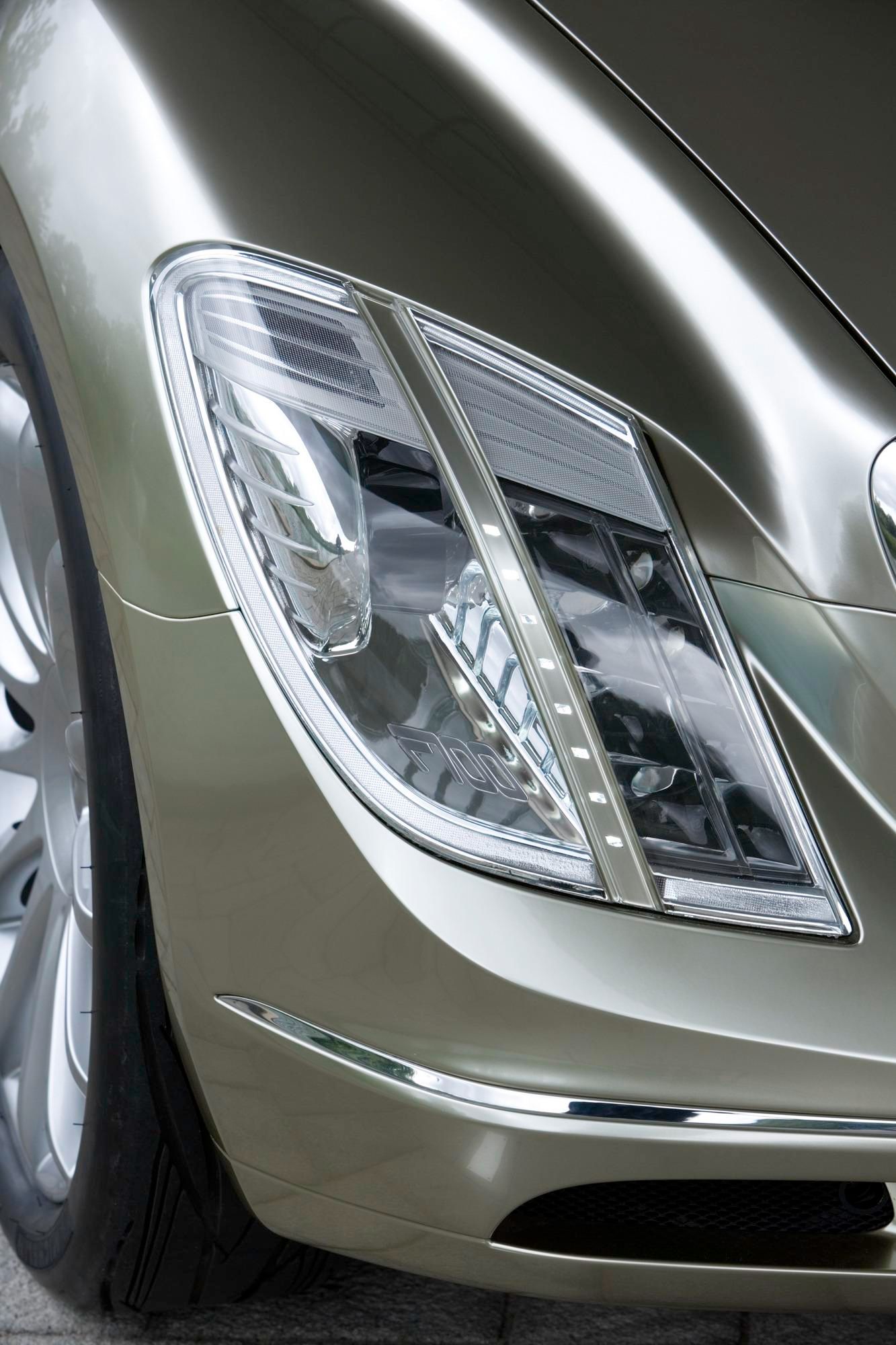 A very special cinema experience is provided more or less in real time by the Roadview function: Two cameras observe the surrounding traffic. One is located behind the upper edge of the windshield and serves primarily as a sensor for the night view assist or the lane assistant; a second is installed in the “fin” at the rear edge of the car roof. The images captured by these cameras can be transferred to the 8-inch monitors in the head restraints, as an alternative to the entertainment program. Particularly when the images are shown in the direction of travel, the head restraints appear “transparent” and the sense of spaciousness is enhanced even more for the passengers in the rear.
A very special cinema experience is provided more or less in real time by the Roadview function: Two cameras observe the surrounding traffic. One is located behind the upper edge of the windshield and serves primarily as a sensor for the night view assist or the lane assistant; a second is installed in the “fin” at the rear edge of the car roof. The images captured by these cameras can be transferred to the 8-inch monitors in the head restraints, as an alternative to the entertainment program. Particularly when the images are shown in the direction of travel, the head restraints appear “transparent” and the sense of spaciousness is enhanced even more for the passengers in the rear.
-----
The design
Advanced Design means giving shape to the future at Mercedes-Benz. Technically, every research car is a laboratory on wheels which, with new concepts, gives initial answers to the question of the further development of mobility. Parallel to this, Advanced Design as part of the Design unit of the Mercedes Car Group pursues research into the styling of the future: What trends in technology and society will change our perceptions of the automobile in the next years and decades? What messages should cars send out through their design to the world around them in future? And with what stylistic devices can the design idiom of Mercedes-Benz be refined and supplemented? “The research cars might be called the free program of the Design unit. The impact of formal elements can be tested in them without having a direct bearing on a coming production vehicle,” says Professor Peter Pfeiffer, Senior Vice President Design, Mercedes Car Group.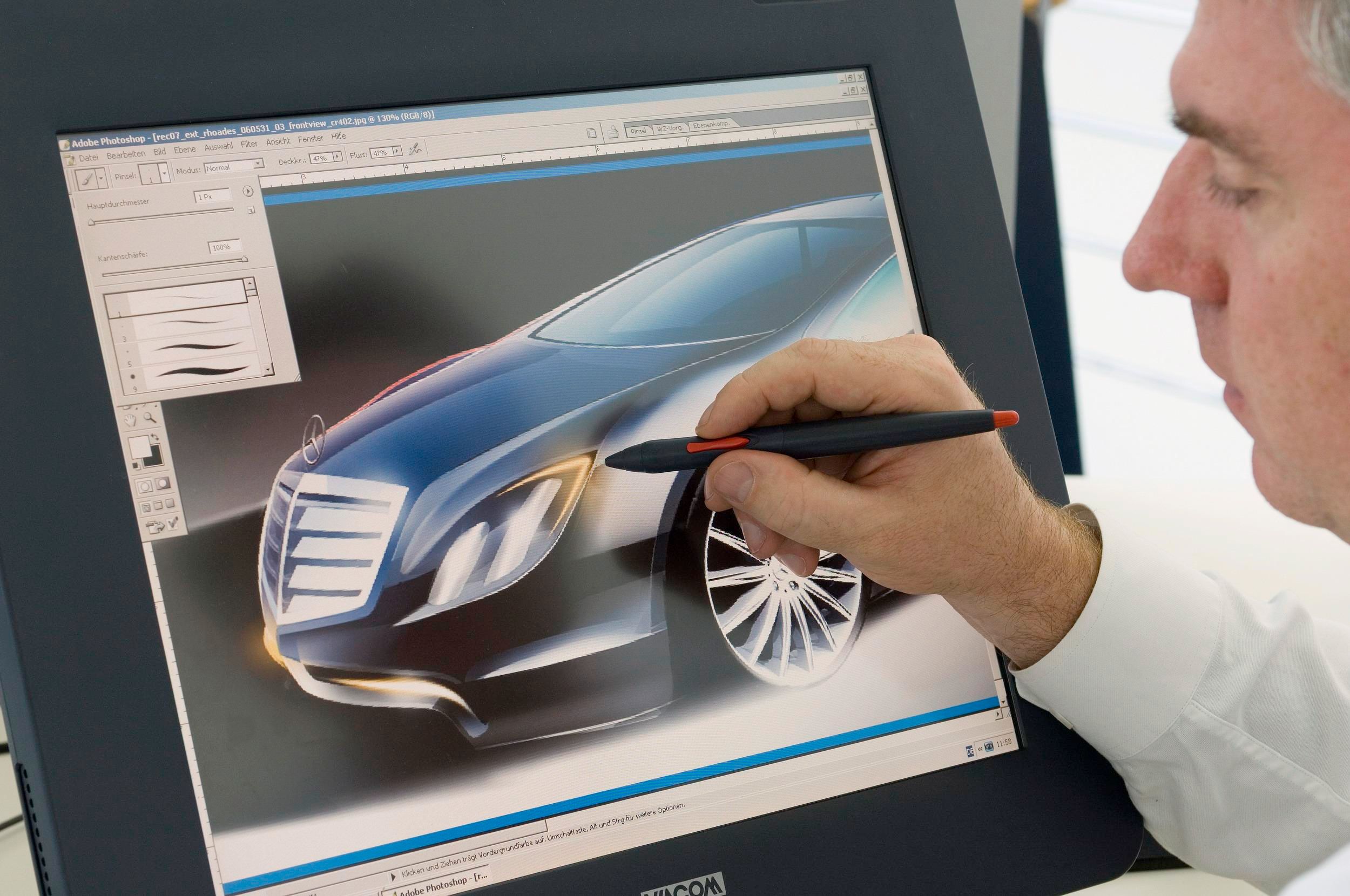 But one aspiration always is the focus of attention: a research car should embody all brand values of a Mercedes-Benz. The preview of things to come always must be designed against the backdrop and with the awareness of being the most tradition-steeped automobile brand in the world. This applies to the F 700 even more so than to its predecessors in the line of research cars: the F 700 does, after all, represent classic core competencies of the brand Mercedes-Benz as a superior touring sedan – comfortable transportation in an unperturbed style especially over long distances, and at the same time a befitting and altogether status-conscious manner.
But one aspiration always is the focus of attention: a research car should embody all brand values of a Mercedes-Benz. The preview of things to come always must be designed against the backdrop and with the awareness of being the most tradition-steeped automobile brand in the world. This applies to the F 700 even more so than to its predecessors in the line of research cars: the F 700 does, after all, represent classic core competencies of the brand Mercedes-Benz as a superior touring sedan – comfortable transportation in an unperturbed style especially over long distances, and at the same time a befitting and altogether status-conscious manner.
The exterior design: Inspired by nature
The F 700 is a futuristic interpretation of the classic sedan theme. It combines generous spaciousness and outstanding comfort with a claim to particular environmental friendliness and intelligent communication through the innovative control and display concept. In its design, inspirations from nature join together with consciously displayed technical innovations. Flowing, smooth surfaces and precise, tense lines merge into a harmonious overall shape – the embodiment of an automobile which is as efficient as it is luxurious.
The styling of the F 700 took shape in the Mercedes-Benz Advanced Design Studio in Irvine, California . The basic form of the F 700 unmistakably is inspired by nature. As already had been practiced in the Mercedes-Benz bionic car, a 2005 concept car, ideas and construction principles from nature were adopted.
“Aqua Dynamic” is what the designers term this design idiom. As direct quote a “back fin” adorns the roof; it is used for antennas, the reversing camera and the third brake light.
The very first glimpse of the F 700 shows that an extraordinary amount of space has been given to the occupants here – technology takes a back seat as it were. The silhouette is dominated by the unusually long wheelbase: with overall length being 5.18 meters, the distance between axles attains the imposing length of 3.45 meters. For comparison: the overall length of the F 700 makes it shorter than the long-wheelbase version of the current S-Class, but the F 700 wheelbase exceeds that of the current model by impressive 28.5 centimeters. The front end is correspondingly short – the particularly compact DIESOTTO drive makes this possible.
Tense lines create stretched elegance
The side view is defined by highly tense curves. This is true of the roof contour, but especially of the concise shoulder line: it starts out by continuing the line created by the front wheel arch a short way, and then carries over in a sweeping curve to the rear end. This tense line gives the F 700, painted in ALU-BEAM technique in the color gold, its dynamism and elegance.
The distinctive front fenders likewise are inspired by a current production model, the S-Class. But here again the theme has been taken further and the fenders have been very distinctly sculpted. The side skirts are gently integrated into the flowing forms. The door handles are recessed and the exterior mirrors are little works of art – nothing should unnecessarily resist the flow of air. The 21-inch wheels are designed like turbine blades. Luminescent strips on the wheel arches emphasize the contours and size of the tires. The transparent cover over the rear wheels enhances aerodynamic efficiency.
It is not only the long wheelbase which provides an indication of the unusual, extremely spacious and flexible interior concept – before one even sees the inside. The two large glazed areas in the roof, as a transparent link between inside and out, are suggestive of the inside breadth which the interior conveys. A special feature is the right rear door: whereas the three other doors open conventionally (hinges at the forward edge, handles at the rear), the fourth door is hinged at the rear. This facilitates boarding and leaving for the passenger when the REVERSE seat is positioned opposite the direction of travel.
Despite the futuristic design idiom, the F 700 definitely is a Mercedes-Benz. An essential element of the brand identity is the clear-cut radiator grille, which emphasizes elegance and status. No other manufacturer has refined the radiator grille over the decades with such consistency as Mercedes-Benz.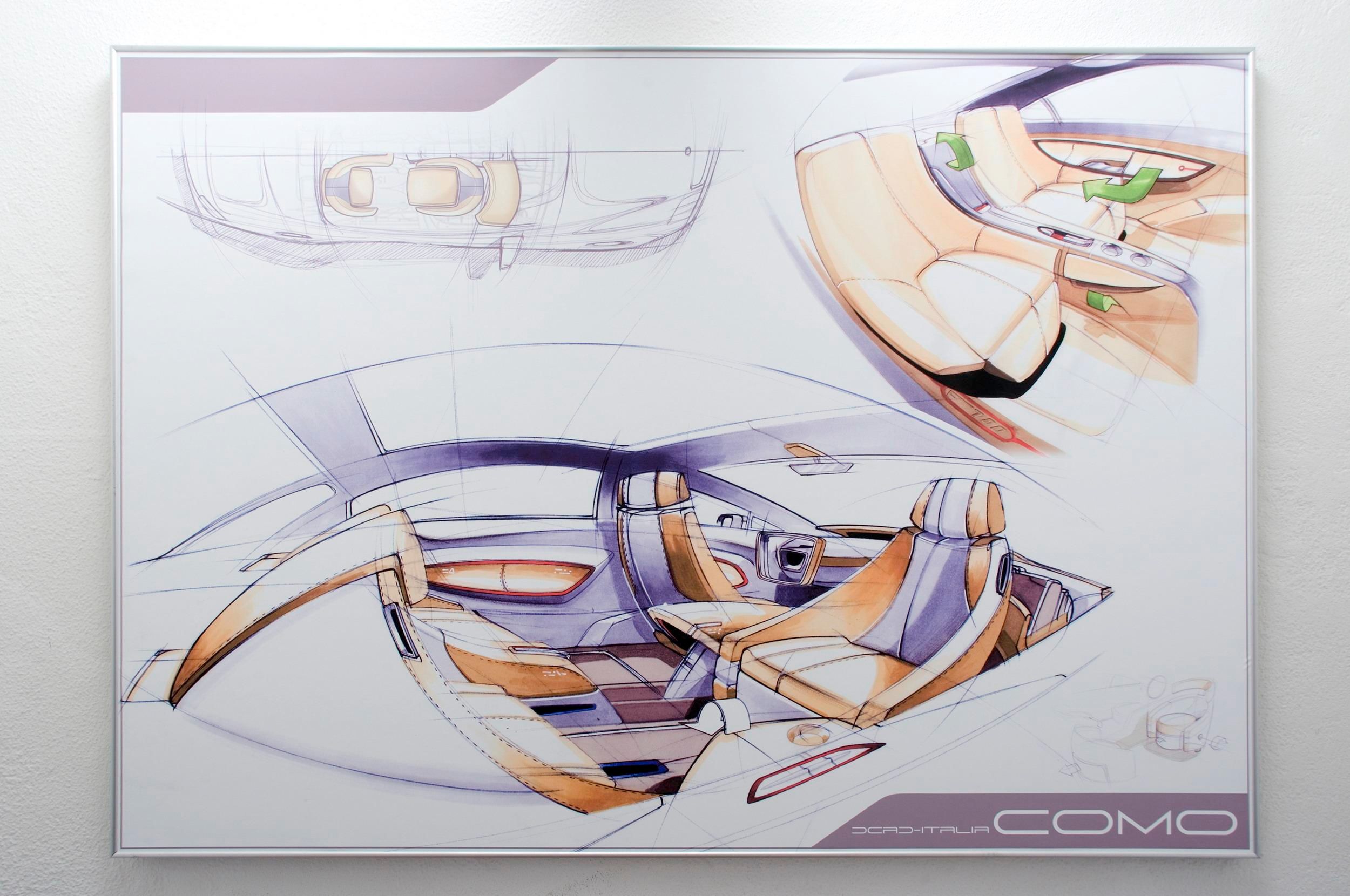 The headlamp units also clearly follow the styling tradition of Mercedes-Benz. Despite highly innovative elements like laser scanners or LED driving lights they take up the twin-headlamp motif and interpret it in a vertical form with sophisticated stylistic devices. The laser scanners that gather roadway data for the active PRE-SCAN suspension are positioned on the outside. They make the light units veritable eyes of the vehicle: different from any conventional automobile the F 700 “sees” and reads the condition of the road ahead.
The headlamp units also clearly follow the styling tradition of Mercedes-Benz. Despite highly innovative elements like laser scanners or LED driving lights they take up the twin-headlamp motif and interpret it in a vertical form with sophisticated stylistic devices. The laser scanners that gather roadway data for the active PRE-SCAN suspension are positioned on the outside. They make the light units veritable eyes of the vehicle: different from any conventional automobile the F 700 “sees” and reads the condition of the road ahead.
Looks that reveal a strong character, by day or night
Visually separated from the laser scanner by a painted rib is the driving light function employing all LED technology. The light units consisting of linear LED arrays are arranged in two vertical rows. Each linear LED array has a lens superposed. A third vertical row of individual high-performance LEDs functions as daytime driving light. Together with the wraparound contour lights they give the F 700 an unmistakable appearance even by night.
The rear end completes the flowing silhouette of the F 700. The C-pillars are drawn far back and the backlight is inserted at a shallow angle. The lightly formed wheel arches and the gently molded trunk lid in turn bridge the gap between the rich history of the Mercedes-Benz brand and its future. The rear end is inspired by the vehicles of the 1940s and 1950s, but is reinterpreted with stylistic devices of the present and future: the tail lights take up the vertical LED light strips of the headlamps, the integral spoiler lip is aerodynamically optimized, and finally the diffusor in the rear apron permits the efficient treatment of air flow.
Interior design: Harmonic balance between technology and nature
The very first glance into the interior of the F 700 conveys a clear message: comfortable travel and well-being are interpreted in a completely new way on board this vehicle. The spacious interior, the innovative, multifunctional configuration of the seats, or the use of elegant but natural materials enable an extremely relaxed form of transportation.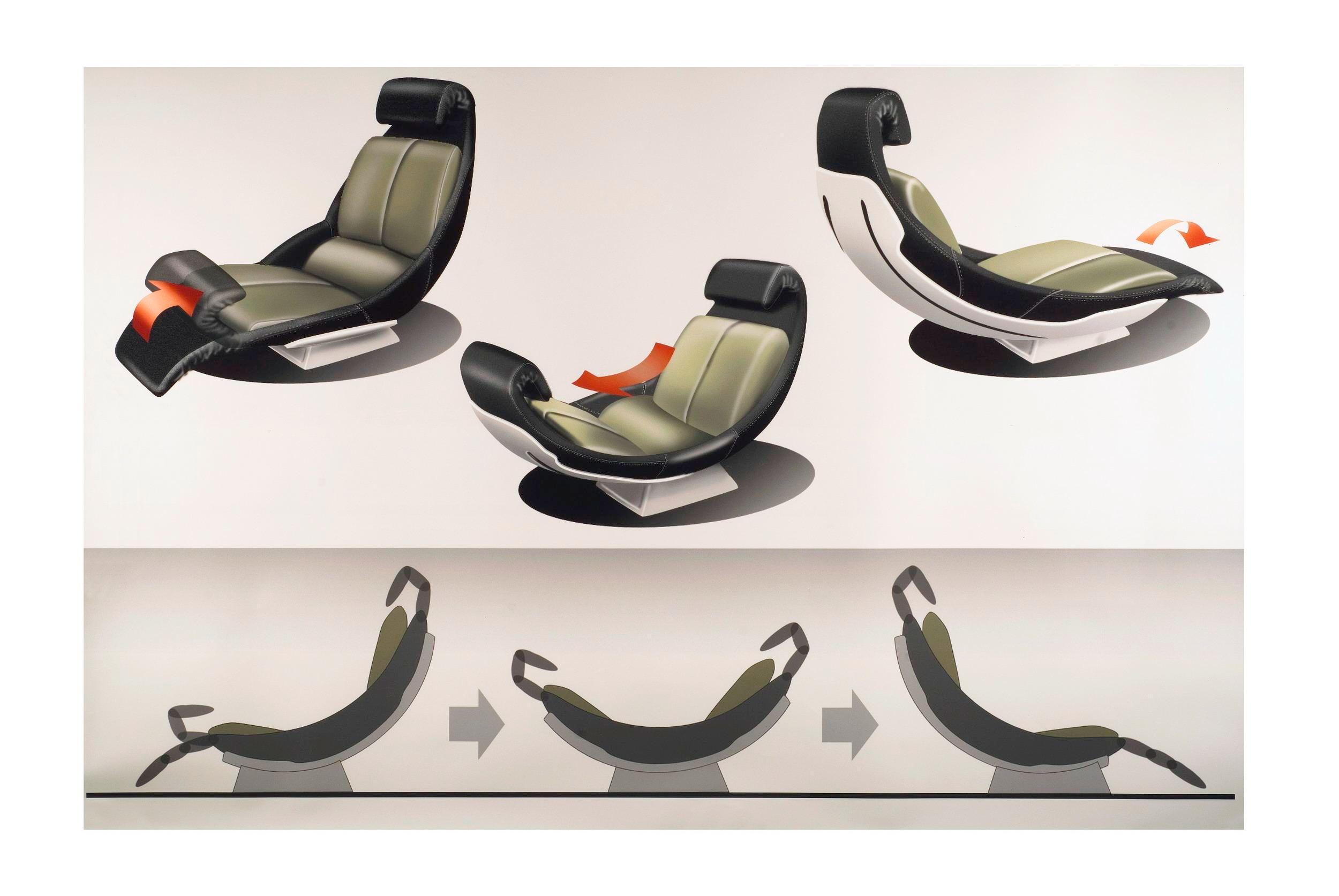 Resource-conserving mobility will gain ever increasing significance in future according to the analyses of the DaimlerChrysler futurologists. The conservation of energy reserves refers not only to fuel and the environment, but just as much to the well-being of the passengers: For many people, the distances they cover will not increase, but the time they spend on the road will. The traffic in the rapidly growing megacities of this planet calls for mobile living spaces which afford highest comfort on wheels.
Resource-conserving mobility will gain ever increasing significance in future according to the analyses of the DaimlerChrysler futurologists. The conservation of energy reserves refers not only to fuel and the environment, but just as much to the well-being of the passengers: For many people, the distances they cover will not increase, but the time they spend on the road will. The traffic in the rapidly growing megacities of this planet calls for mobile living spaces which afford highest comfort on wheels.
An essential component of this well-being is the freedom of movement inside the vehicle and the possible seating alternatives. The F 700 breaks up the conventional, rigid seating order of the touring sedan (with its two seats in the first row and two more in the back). The heart of the novel seat concept in the Mercedes-Benz research car is the REVERSE seat – a completely new design thought out for the right rear seat, permitting individual seat positions both facing the direction of travel and in the opposite direction.
So the interior offers very different possibilities for use: Four persons sit in the conventional manner facing the direction of travel. When the front passenger seat is unoccupied it can be moved all the way forward to its park position to create room for the relax mode: extremely large legroom, a large footrest and a tilted REVERSE seat ensure relaxed travel even over long distances.
The automobile as a private room
At the push of a button the innovative seat swivels in the opposite direction: The back seat passenger no longer looks to the front, but turns his attention away from the road. He “retires”, can hold a confidential chat face to face with his companion on the left rear seat. He can work, enjoy the entertainment program or simply take a rest. Owing to the REVERSE seat’s variability, this sedan affords entirely new freedoms for traveling in complete ease.
Of course, the high-quality, elegant and light interior design of the F 700 also conduces to relaxed travel. It thrives on the tension between clear-cut, direct forms and organic, living surfaces; it displays harmony in its colors and variation in its materials. The blueprint from the Advanced Design Studio in Como, Italy, interprets the future of the luxurious sedan in warm colors, in harmonious brown and beige tones, combining “technical” surfaces with surfaces featuring natural materials like cork and leather.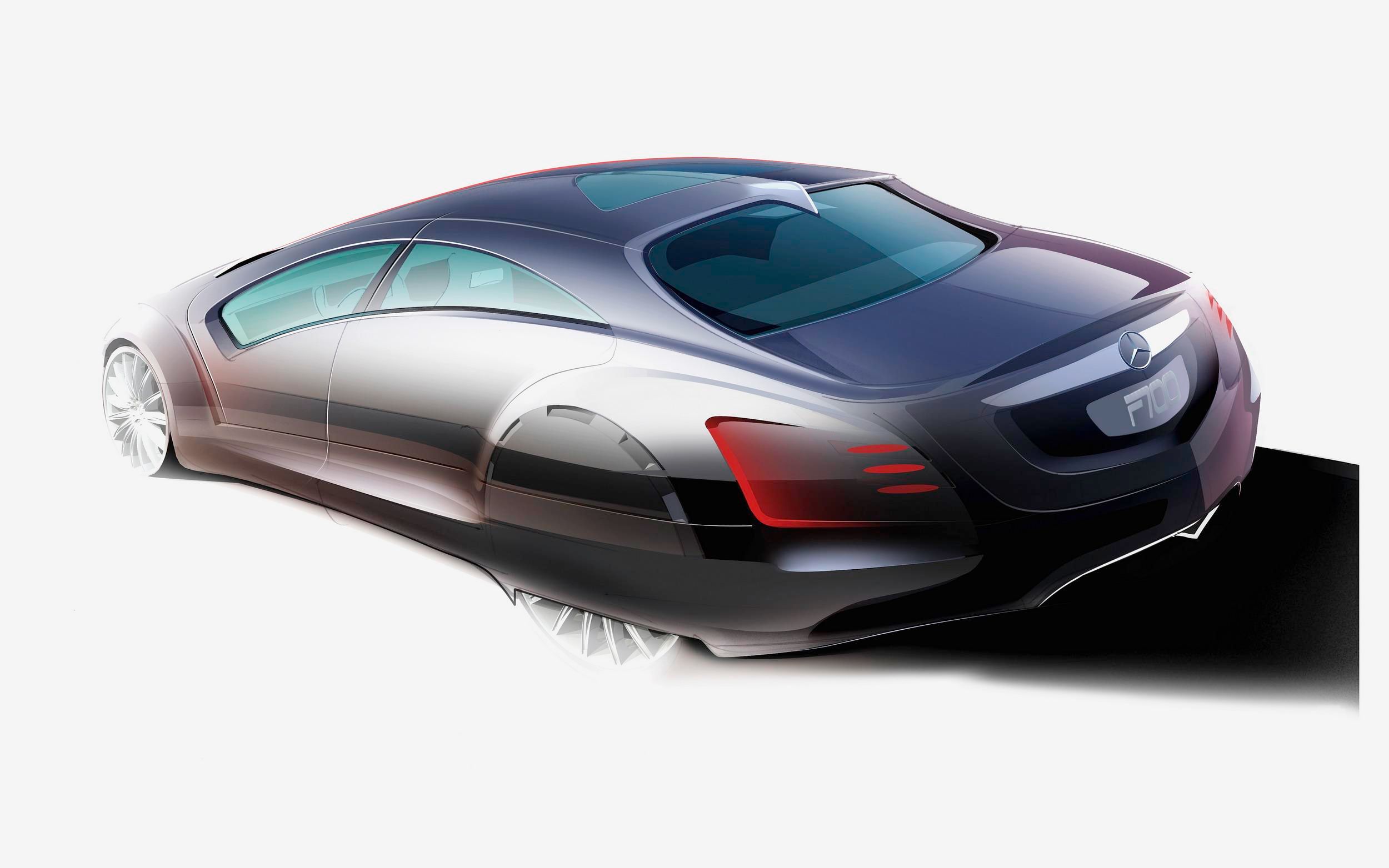 The innovative technology in the F 700 creates the basis for the impression of spaciousness and clarity: the innovative SERVO display at the base of the windshield employs mirror reflection technology to render the massive hood of a conventional instrument panel superfluous. The cockpit is shallow and low-profile. And owing to the radically simplified control and display concept, the number of switches is reduced to a minimum. The slim hood at the front, at the windshield, is used entirely as an outlet for the draft-free automatic climate control.
The innovative technology in the F 700 creates the basis for the impression of spaciousness and clarity: the innovative SERVO display at the base of the windshield employs mirror reflection technology to render the massive hood of a conventional instrument panel superfluous. The cockpit is shallow and low-profile. And owing to the radically simplified control and display concept, the number of switches is reduced to a minimum. The slim hood at the front, at the windshield, is used entirely as an outlet for the draft-free automatic climate control.
Inner harmony of colors and materials
The balance and harmony of the color scheme is the result of a combination of brown leather, matching Alcantara and open-pored cork for the door liners, the roof lining or the center console, which runs all the way through the interior. The seats are upholstered in beige leather with middle portions in matching Alcantara. Painted aluminum can be found on all operating panels and the SERVO-HMI.
Transformation by the REVERSE seat
The trick of changing around the interior with the REVERSE seat is accomplished at the push of a button: the front passenger seat moves all the way forward into its parking position; as it does so the backrest partly folds down into the cockpit. Huge legroom now is available to the right rear passenger. A footrest can be extended and the entire seat can be placed in a flat relax position.
But the REVERSE can do much more. As the front passenger seat moves forward the REVERSE seat also travels about 60 centimeters forward and does an elegant “backward roll”. What was previously the seatback becomes a cushion, and the seat cushion rises up and together with the headrest becomes a backrest.
The design of the REVERSE seat also took some doing. The backrest of a seat is always appreciably longer than the seat cushion. The two seat halves of the REVERSE seat are identical, each consisting of five flexibly connected elements. A well-thought-out mechanism pushes these segments apart as soon as they are used as a backrest, with the outer segment then serving as head restraint. In the opposite direction, an electric motor pulls the segments together again to create a closed surface as soon as they are used as a seat cushion.
Entertainment in exclusive surroundings
If desired, the rear seat area can be turned into a cinema. A monitor with an overall diagonal display measurement of 51 centimeters slides out of the partition to the luggage compartment and surprises the passengers with fascinating images. A surround sound system creates a cinema atmosphere. More than anything else though the monitor delivers fascinatingly deep images with its 3D technology. The 3D representation carries the viewer right into the middle of the action; the three-dimensional images make the scenery appear so close you can almost touch it. Complementing stereophonic sound is delivered by a high-quality surround sound system. In the rear seat area, the center tunnel, which extends the full length of the interior, features a heated or cooled container for drinks and snacks.

